
This article is available to Premium members of Popular Archaeology.
Become a member or upgrade to a Premium membership: REGISTER HERE.
Member Login:
This is the example article

This article is available to Premium members of Popular Archaeology.
Become a member or upgrade to a Premium membership: REGISTER HERE.
Member Login:

During the High Middle Ages, whilst Western Europe was still coping with the sociopolitical disorder and economic decline which had engulfed the continent since the fall of Rome, the Hohokam of the North American Southwest were reaching their pinnacle of economic prosperity and social organization (Brown 1988: 1-61; Smith 2004: 14). Interestingly, the Hohokam or ‘those who have gone before’ are not as well known as some of their contemporaries, such as the Pueblo III era Anasazi, the Aztecs and the late-Classic/Postclassic Maya (Justice 2002: 275; Milner 2009: 680; Webster and Evans 2009: 596). Nonetheless, the Hohokam were a productive and expansive culture, whose innovations influenced subsequent Native American and post-Columbian generations (Browman et al. 2009: 320; See also Smith 2004: 23-93).
Center to Hohokam culture was their technologically sophisticated canal engineering which was utilized to irrigate numerous sub-communities (Abbott 2000: 48). At its peak (c. AD 1150-1450), the Hohokam hydraulic system was the largest of the day and provided water (and consequently food) to tens of thousands of rural inhabitants, rivaling the excellence of the ancient Roman aqueducts — an urban engineering marvel (Medchill 2012, pers.comm.; Logan 2002: 31; cf Aicher 1995: 6). Moreover, through a vast array of human-made waterways, otherwise disunified subcultural ‘villages’ were integrated into a highly complex agricultural based society (Abbott 2000: 143; Abbott et al. 2003: 15). Thus, one may argue, that the increasing needs of an agrarian society was an incentive for the centralized management of inter-communal water facilitation, which in turn resulted in a closely knit farming society that was regionally unsurpassed in crop production (cf Milner 2009: 692, 694).
How is archaeological survey and excavation changing our understanding of Hohokam agriculture and irrigation? To answer this, I shall critically discuss several examples from both the Preclassic (c. AD 700-1150) and Classic (c. AD 1150-1450) Hohokam Periods. Specifically, I will draw from a host of archaeological subcategories such as botanical, hydrological and settlement patterns, with some perspectives coming from my recent fieldwork at the Riverview Archaeological Project.
Part I: The Dry Farmers
Evolving Cultigen Patterns
Research into the selection of agricultural crops may be a rather unique reflection of the evolution of Hohokam irrigation. For example, archaeobotanical evidence has revealed that cultigens, such as the legume tepary and the herb amaranth (Fig. 1), were popular with the Classic Hohokam especially during the Sacaton-Soho (Sedentary) transition phase (c. AD 1050-1150) (Browman et al. 2009: 320-321; Elson 1998: 7; Barnes and Breternitz 1988: 54). Other agricultural genera excavated from Classic Period contexts include cucurbita (squash) and P. vulgaris (common beans) (Foster 2012: 39; Kwiatkowski 2003: 50). This is in stark contrast to their more homogenous Preclassic taste for ‘traditional’ cultigens such as maize — a species found sparingly in Classic contexts but abundantly in Preclassic phases (Browman et al. 2009: 316; cf Foster 2012: 91). Some have explained this apparent disparity between Preclassic and Classic horticulture as indicative of archaeological bias from poor sampling techniques (See Browman et al. 2009: 316, 318).
Perhaps there is validity to this argument. Funding for Hohokam field research has been infinitesimal since the start of the Great Recession and this has impacted specialist studies (Howard 2012, pers. comm.). However, an equally valid interpretation is that a growing diversity of plant based food products during the Classic Period was a direct result of expanding farming communities; a development caused by the increasing sophistication of the canal system and exploitation of arable land (See also pre-Columbian ‘soil changes’ in Fish 2000: 258-259). Arguably, the plethora of these otherwise ‘Mesoamerican’ species in Classic Hohokam contexts implies escalating trade with the south which may be the product of increased socioeconomic complexity — a process also reflected in Hohokam irrigation (see below) (Abbott 2003: 15; contra Foster 2012: 91–92).
As the irrigation systems became more integrated, farming intensified and the Classic Period Hohokam added to their subsistent resources by domesticating wild plant types as can be seen in the cultivation of the monocot agave, an arid perennial (Phillips 2009: 698). Additionally, survey and excavation of several sites, such as Hodges, have indicated that these ‘transplanted desert species’ included the now virtually extinct lycium berlandieri (a Southwest American wolfberry), hoffmannseggia densiflora (a rushpea potato) and a variety of species from the subfamily chenopodioideae for pseudocereal usage (Gibbon 1998: 364; Fish 2000: 260; Hodgson 2001: 236; Moerman 2010: 128, 437; Scupin and DeCorse 2003: 193). Moreover, the Hohokam cultivated the genus of hordeum known as pusillum (a wild grass), most likely to provide a crop that could be harvested year-round (Hodgson 2001: 66). However, as the Civano Phase Hohokam (c. AD 1300-1375) were faced with horrendous cycles of droughts and floods which negatively impacted their ecosystem, they were forced to rely on broader subsistence strategies (Elson 1998: 7; Howard 2012, pers. comm.; Phillips 2012, pers. comm.).
Living off the Land
For example, evidence from the Tucson occupation zone (see below) suggests that the Hohokam established seasonal camps to obtain supplemental food sources from the ‘thriving desert’ (Fish et al. 1992a: 14-17; Blythe 2009: 45). On the other hand, these ‘outposts’ may have been positioned in familiar terrain for the express purpose of exploiting certain wild species to support communal sustenance. For instance, archaeological evidence has indicated that villagers foraged for cacti fruit from species such as C. gigantea (saguaro), which became an essential staple of their diet (Phillips 2009: 692). However, it should be noted that statistical analysis of cacti density patterns has implied that systemic foraging of C. gigantea seeds would hardly meet the needs of a pre-Columbian village community (Kwiatkowski 2003: 52-54). Whatever the case may be, arguably the Hohokam maintained a somewhat ‘semi-hunter-gatherer’ lifestyle (cf Bayman 2001: 273-274).
Fascinatingly, excavations of food processing sites at Nogales revealed the usage of plant based foods and herbs as medicine (Eppinga 2002: 10-11). It therefore follows that the Classic Hohokam possessed at least a rudimentary understanding of nutritional values. From this premise, one may argue that simple nutritional requirements may have been a factor in Classic Period horticulture. For example, archaeozoological analyses of animal bones excavated from sites in the Phoenix and Tucson areas have suggested that the dramatic escalation in the number of settlements during the Classic Period caused a precipitous decrease in the local wildlife (Sheridan 2012).
Logically, any decline in wild game would have resulted in a corresponding reduction in dietary sources of ‘complete proteins’ (See Gropper and Smith 2005: 239). Consequently, cultigens that contain the essential amino acid lysine — such as amaranth — would have become highly valuable to a predominately agrarian culture (Huckell and Toll 2004: 90-91; See also Browman et al. 2009: 321; cf Sheridan 2012). What may be inferred is that the Hohokam, potentially, became victims of their own success in irrigation and agriculture. Regardless, it is increasingly clear from the archaeological evidence that similar to their engineering feats, the Hohokam had designed a complex agricultural system.
Part II: Irrigation and Settlement Structure
The Sacredness of Water
Prehistoric canal research of the ‘occupation zones’ has greatly changed our understanding of Hohokam irrigation by revealing its role in sociopolitical structure (Howard 2012, pers. comm.). A role that evolved in no small way from the Hohokam’s concept that water was sacred — a celestial gift from God (Medchill 2008, pers. comm.; See also Lockard 2008: 245). Thus, water was intimately linked to inter and intra social structures. A unique example of this association may be found in the area known as Canal System Two, or CS-2, where three identified sites may have been part of a intercommunal nexus bound by irrigation needs (Abbott 2000: 67; cf ‘irrigation communities’ in Bayman 2001: 273, 287).
Casa Buena & the Grand Canal Ruins
Northwest of the Salt River, excavations carried out at the site of Casa Buena revealed an expansive Classic Period village settlement which, interestingly, possessed a large platform-based mound (Abbott 2000: 67-68). This is not uncommon. Hohokam mounds have been found elsewhere (Fig. 2) in the Salt River area and it has been suggested that they served a ritualistic function (Howard 2012, pers. comm.). However, northeast of Casa Buena another mound was found at the Grand Canal Ruins leading archaeologists to speculate that there was a link between the two settlements (Abbott 2000: 68, cf 147). To be sure, excavated pottery sherds from Casa Buena and the Grand Canal Ruins revealed a high degree of exchange in locally produced ‘plainware’ between the two communities, suggesting a ‘social relationship’ of some sort (See Abbott 2000: 145-148). This may be supported from similar burial practices vis-à-vis the inhumation/cremation ratio, and the analogous types of grave goods (Mitchell and Brunson-Hadley 2001: 58).
Pueblo Grande
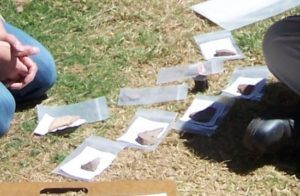
Figure 3: An assemblage of artifacts, specifically red-on-buff pottery sherds and lithics from Canal One (Riverview). Photo courtesy of Heidi Emma (2012)
Southeast of these sites is Pueblo Grande, a village which possessed a local pottery industry as well (Abbott 2000: 18). However, here ceramic production was on a much more prodigious scale. For example, chemical analysis has revealed that a wide spectrum of Salt River sand types and outcrops were employed for locally produced pottery fabrics such as plainware (Mitchell and Brunson-Hadley 2001: 46; Abbott 2000: 79-83). Such data underscores the scope of their ceramic industry in comparison to their contemporaries (cf Abbott 2000: 147-151). Yet, excavations also revealed an unusually high quantity of the socially coveted redware (cf Fig. 3), a non-local ceramic unobserved in contexts at Casa Buena and the Grand Canal Ruins (Abbott and Walsh-Anduze 1995: 93-94; Abbott and Schaller 1994: 100). Thus, it may be plausible to deduce that Pueblo Grande was a ‘regional’ socioeconomic center — but to what end?
Irrigation Alliance
Uniquely, all three of these sites shared two CS-2 canals in what is labeled the ‘North Occupation Zone’ (See Abbott 2000: 87). However, what is captivating is the fact that Pueblo Grande is strategically situated at the head gates of both canals — tactically in a position to exhibit influence over the other two sites if desired (Earle and Doyel 2008: 34; cf Yoffee 2004: 11-12). What can be said then? Perhaps the ruins of the Grand Canal are in actuality a colony of Casa Buena ‘pioneers’, both of which formed an axis with Pueblo Grande — itself responsible for the water management and irrigation development of the area (cf Abbott 2000: 147; Fish et al. 1992a: 15; Morgan 1994: 108; Abbott et al. 2003: 15). Under such circumstances, Casa Buena and the Grand Canal Ruins could be viewed as the ‘peripheral’ to a Pueblo Grande ‘center’ (See ‘site hierarchy’ in Renfrew and Bahn 2008: 184).
Equally, Pueblo Grande may have used their ‘water rights’ as leverage on neighboring polities to compel ‘membership’ in a canal system they monopolized (See Abbott and Schaller 1994: 101). To be sure, it has been suggested that disputes over ‘canal integration’ formed the foundation of intersocial organization for the early Classic Period (Abbott et al. 2003: 15). Moreover, such ‘interpolity transactions’ may explain the disparities between Pueblo Grande and Casa Buena/Grand Canal Ruins pottery types (cf Maya ‘interpolity competition’ in Rice 2009: 123). For example, it has been suggested that redware exchange was used in a ‘reciprocal’ manner between village families (Abbott 2000: 139-140; cf Renfrew and Bahn 2008: 360-361).
Considering its value, however, it is equally plausible that redware was a form of payment for services rendered from one village to another or a symbol of respect to the social hierarchy of a community (cf ‘Hohokam chiefdom’ in Earle and Doyel 2008: 33). Thus, it may be posited that the Pueblo Grande-Casa Buena-Grand Canal Ruins’ sector constituted an agricultural league, consisting of semiautonomous villages bound by a common need for water (cf Yoffee 2004: 11-12).
Early Irrigation and the complexities of a Civilization
In the past, archaeologists interpreted the Hohokam ‘canal social system’ (see above) as a product of diffusion from pre-Columbian Mexican cultures (Foster 2012: 39). However, this has been disputed as radiometric dating indicates that the earliest Hohokam canal — a ‘small ditch’ in the vicinity of Riverview — was constructed during the 1st century AD (Earle and Doyel 2008: 31; contra Fig. 4). In addition, researchers have concluded that the Hohokam of the Formative Period (c. AD 1-750) were ‘dependent on irrigation’ as early as the middle of the first millennium AD (Phillips 2009: 692). This is in no doubt a result of Preclassic subsistence requirements brought on by the gradual sedentism of the Sacaton Phase (c. AD 750-1050) (See Phillips 2009: 698). It is therefore logical to assume that the demands placed on older, less sophisticated canals would be too great. Consequently, a ‘Preclassic’ construction boom in ‘single ditch’ canals took place, thus setting the stage for the Classic Period integration (Earle and Doyel 2008: 31-32).
__________________________________

Figure 4: Riverview’s Canal One excavation (in progress) as it appeared on April 16, 2012. At this point during the excavation it was assumed that there were actually two canals running parallel to each other, hence the great length of the trench. Regardless, after weeks of digging — old school archaeological style — our sixteenth trench intercepted the first Prehistoric waterway at the site. Of course, the full scope of the discovery was not fully realized for several weeks. Photo by Paul J. De Mola (2012)
__________________________________
Interestingly, it appears that the causes behind Preclassic irrigation development parallel the socioeconomic factors which drove the hydraulic engineering of the Classic Period. Moreover, while archaeology has definitely increased our understanding of Hohokam irrigation and agriculture, the various evidences presented here seem to suggest that one cause was the catalyst for all changes: sedentism. However, we should not assume that the Hohokam were an entirely sedentary culture at any stage of their evolution. For example, surveys of the Tucson landscape have indicated that the mountainous topography was unsuitable for the type of large scale irrigation seen in the north occupation zone. This may be supported by the late arrival of irrigation in this area (Earle and Doyel 2008: 31).
In addition, ethnographic studies have inferred that the Tucson Hohokam made use of both anthropogenic and natural reservoirs to store water for agricultural purposes (Bayman 2001: 273-273; Fish et al. 1992b: 43). However, could not a mobile community utilize ‘large water holes’ while foraging too? Perhaps certain Hohokam ‘sects’ were only semi-sedentary and had a lifestyle that reflected their Paleoindian forbearers (See Browman et al. 2009: 313-321). This might better explain the motivation behind their seasonal camps (see above). In comparison, neighboring cultures such as the Mogollon coped with hilly landscapes through an institutionalized synthesis of agricultural and hunter-gatherer economies (Shaw and Jameson 1999: 45; Darvill 2008: 286). Consequently, it may be postulated that the Tucson area Hohokam were not nearly as sedentary as their Phoenix counterparts and were, in point of fact, quite mobile.
Endings
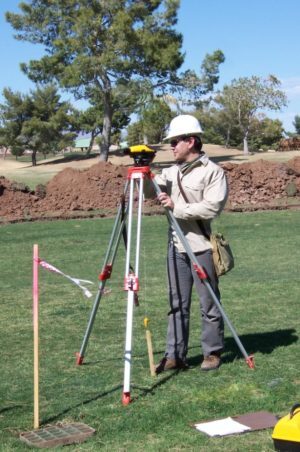
Figure 5: Here, Paul Joseph De Mola is measuring strata column elevation for trench nine using an automatic level (Riverview). Photo courtesy of Dutch Duering (2012b)
Throughout this essay, I have discussed how archaeological survey and excavation (Fig. 5) has been used to change our understandings of agricultural patterns by highlighting some of the changes that the Hohokam brought to their own diets. Moreover, I have examined various excavated sites to display how Hohokam irrigation was critical to Preclassic and Classic societies. These two aspects of Hohokam culture while distinguishable are, of course, inseparable. In fact, it may be said that canals formed the thread that interweaved Hohokam agricultural and irrigation strategy. That is to say, agriculture was as intertwined with irrigation as day is to night. To this end archaeological research has been indispensable in our knowledge of the Hohokam as a ‘people’.
Dr. Jerry Howard (2012, pers. comm.) has stated that the expansion of settlements during the latter Classic Period caused a subsequent overexploitation of resources during the Polvoron Phase (c. AD 1375-1450) setting the stage for an ecological crisis. Tragically, with numerous droughts came a decline in irrigation, which in turn caused a collapse of the already strained agricultural system. Subsequently, villages were abandoned thereby reducing human power to maintain operating canals which only further depleted food sources. As a result, the entire Hohokam economic structure descended into social chaos. Ergo, it may be argued that at the height of their civilization — during the great days of the early Classic Period — the Hohokam were inadvertently sowing the seeds of their own demise.
Notes
Since the Hohokam disposed of their rubbish in waterways, the most indicative evidence for a canal is artifacts of which pottery is the most common (Medchill, 2012, pers. comm.). However, it must be noted that excavation is not an exact method of science. For example, after the first two weeks of digging at Riverview, only two shards were found in the first ten intercept trenches. These specimens were identified as Classic Hohokam red-on-buff ware (Howard 2012, pers. comm.). Unfortunately, because of the dearth of material culture from these trenches, it was concluded that none of them intersected a canal.
Bibliography
Abbott, D. R., 2000. Ceramics and Community Organization Among the Hohokam. First ed. Tucson: University of Arizona Press.
Abbott, D. R., Breternitz, C. D. & Robinson, C. K., 2003. Challenging Conventional Conceptions. In: D. R. Abbott, ed. Centuries of Decline during the Hohokam Classic Period at Pueblo Grande. First ed. Tucson: The University of Arizona Press, pp. 3-23.
Abbott, D. R. & Schaller, D. M., 1994. Ceramics Among the Hohokam: Modeling Social Organization and Exchange. In: D. Scott & P. Meyers, eds. Archaeometry of Pre-Columbian Sites and Artifacts. First ed. Los Angeles: Getty Conservation Institute, pp. 85-112.
Abbott, D. R. & Walsh-Anduze, M. E., 2005. Temporal Patterns without Temporal Variation: The Paradox of Hohokam Redware Ceramics. In: B. J. Mills & P. L. Crown, eds. Ceramic Production in the American Southwest. First ed. Tucson: University of Arizona Press, pp. 88-114.
AGFD, 2003. Crayfish Brochure. Arizona Game and Fish Department. [Online]
Available at: http://www.azgfd.gov/pdfs/i_e/Crayfish_Brochure.pdf
[Accessed 1 July 2012].
Aicher, P. J., 1995. Guide to the Aqueducts of Ancient Rome. First ed. Wauconda: Bolchazy-Carducci Publishers, Inc.
Banning, E., 2000. The Archaeologist’s Laboratory: The Analysis of Archaeological Data. First ed. New York: Kluwer Academic Publishers.
Barnes, E. & Breternitz, C. D., 1988. Excavations at Casa Buena: Changing Hohokam Land use along the Squaw Peak Parkway. Soil Systems Publications in Archaeology, II(11), pp. 49-56.
Bayman, J. M., 2001. The Hohokam of Southwest North America. Journal of World Prehistory, XV(3), pp. 257-311.
Blythe, A. A., 2009. Social Differentiation in Animal Use and Subsistence: A Case Study of the Marana Platform Mound. First ed. Ann Arbor: ProQuest, LLC.
Browman, D. L., Fritz, G. J., Watson, P. J. & Meltzer, D. J., 2009. Origins of Food-Producing Economies in the Americas. In: C. Scarre, ed. The Human Past: World Prehistory & the Development of Human Societies. Second ed. London: Thames & Hudson, Ltd, pp. 306-349.
Brown, T. S., 1988. The Transformation of the Roman Mediterranean, 400-900. In: G. Holmes, ed. The Oxford Illustrated History of Medieval Europe. First ed. Oxford: Oxford University Press, pp. 1-61.
Darvill, T., 2008. Oxford Concise Dictionary of Archaeology. Second ed. Oxford: Oxford University Press.
De Mola, P. J., 2012. Looking south across Canal One. The former cross-trench sixteen now appears to be intercepting a potential second canal. The excavators may be observed working to the immediate southwest of the landscape. [Photograph] (Riverview Archaeological Project).
Duering, W. D., 2012a. Personal Communication. In the field cartography and geospatial engineering instruction. As well as general conversations on the Riverview Archaeological Project, including its sedimentology and artifacts. [Interview] (March 29-April 5, 2012).
Duering, W. D., 2012b. Paul De Mola measuring strata column elevation at trench nine. [Photograph] (Riverview Archaeological Project).
Earle, T. & Doyel, D. E., 2008. The Engineered Landscapes of Irrigation. In: L. Cliggett & C. A. Pool, eds. Economies and the Transformation of Landscape. First ed. Lanham: Alta Mira Press, pp. 19-46.
Elson, M. D., 1998. Expanding the View of Hohokam Platform Mounds: An Ethnographic Perspective. First ed. Tucson: University of Arizona Press.
Emma, H., 2012. Assorted lithics and shards from Canal One. [Photograph] (Riverview Archaeological Project).
Eppinga, J., 2002. Nogales: Life and Times on the Frontier. First ed. Charleston: Arcadia Publishing.
Fish, S. K., 2000. Hohokam Impacts on Sonoran Desert Environment. In: D. L. Lentz, ed. Imperfect Balance: Landscape Transformations in the Precolumbian Americas. First ed. New York: Columbia University Press, pp. 251-280.
Fish, S. K., Fish, P. R. & Madsen, J. H., 1992a. Early Sedentism and Agriculture in the Northern Tucson Basin. In: S. K. Fish, P. R. Fish & J. H. Madsen, eds. The Marana Community in the Hohokam World. First ed. Tucson: University of Arizona Press, pp. 11-19.
Fish, S. K., Fish, P. R. & Madsen, J. H., 1992b. Parameters of Agricultural Production in the Northern Tucson Basin. In: S. K. Fish, P. R. Fish & J. H. Madsen, eds. The Marana Community in the Hohokam World. First ed. Tucson: University of Arizona Press, pp. 41-52.
Foster, W. C., 2012. Climate and Culture Change in North America AD 900-1600. First ed. Austin: University of Texas Press.
Gibbon, G. E., 1998. Archaeology of Prehistoric Native America: An Encyclopedia. First ed. Oxon: Taylor & Francis Group.
Greene, K., 2002. Archaeology: An Introduction. Fourth ed. London: Routledge.
Gropper, S. S. & Smith, J. L., 2005. Advanced Nutrition and Human Metabolism. Sixth ed. Stamford: Wadsworth Cengage Learning.
Hodgson, W. C., 2001. Food Plants of the Sonoran Desert. First ed. Tucson: University of Arizona Press.
Howard, J., 2012. Personal Communication. Regular in the field conversations on the Riverview Archaeological Project, Hohokam culture and interpretion of material remains. [Interview] (March 29-April 5, 2012).
Huckell, L. W. & Toll, M. S., 2004. Wild Plant Use in the North American Southwest. In: P. E. Minnis, ed. People and plants in ancient western North America. First ed. Tucson: University of Arizona Press, pp. 37-114.
Huckleberry, G., 2006. Sediments. In: J. Balme & A. Paterson, eds. Archaeology In Practice: A Student Guide To Archaeological Analyses. Malden: Blackwell Publishing, pp. 338-361.
Hurcombe, L. M., 2007. Archaeological Artefacts as Material Culture. First ed. London: Routledge.
IAE, 2008. Interpreting Archaeological Evidence: Material Culture and Environment. (Level 2 course reader). First ed. Leicester: University of Leicester.
Justice, N. D., 2002. Stone Age Spear and Arrow Points of the Southwestern United States. First ed. Bloomington: Indiana University Press.
Kwiatkowski, S. M., 2003. Evidence for Subsistence Problems. In: D. R. Abbott, ed. Centuries of Decline during the Hohokam Classic Period at Pueblo Grande. First ed. Tucson: University of Arizona Press, pp. 48-69.
Lockard, C. A., 2008. Societies, Networks, and Transitions: A Global History (Volume I: To AD 1500). First ed. Stamford: Cengage Learning.
Logan, M. F., 2002. The Lessening Stream: An Environmental History of the Santa Cruz River. First ed. Tucson: University of Arizona Press.
Medchill, B., 2012. Personal Communication. Instruction in various field methods and their logical applications, including sedimentology. General conversations on the Riverview Archaeological Project. [Interview] (April 2-5, 2012).
Meiguoren, 2012. Mesa Grande Hohokam Ruins Arizona. (Photo) Available at: http://commons.wikimedia.org/wiki/File:Mesa_Grande_Hohokam_Ruins_Mesa_Arizona.jpg.
[Accessed 12 December 2012].
Milner, G. R., 2009. Complex Societies of North America. In: C. Scarre, ed. Our Human Past: World Prehistory & the Development of Human Societies. Second ed. London: Thames and Hudson, pp. 678-715.
Mitchell, D. R. & Brunson-Hadley, J. L., 2001. An Evaluation of Classic Period Hohokam Burial and Society: Chiefs, Priests, or Acephalous Complexity? In: D. R. Mitchell & J. L. Brunson-Hadley, eds. Ancient Burial Practices in the American Southwest: Archaeology, Physical Anthropology, and Native American Perspectives. First ed. Albuquerque: University of New Mexico Press, pp. 45-67.
Moerman, D. E., 2010. Native American Food Plants: An Ethnobotanical Dictionary. First ed. Portland: Timber Press, Inc.
Morgan, W. N., 1994. Ancient Architecture of the Southwest. First ed. Austin: University of Texas Press.
Nelson, G., 2012. Vote signals end for Mesa’s Riverview Golf Course. [Online]
Available at: http://www.azcentral.com/community/mesa/articles/2012/02/21/20120221vote-signals-end-riverview-golf-course.html
[Accessed 25 November 2012].
Phillips, B., 2012. Detailed in-the-field lectures on the geomorphology and sedimentology of Riverview and the greater Phoenix area. [Interview] (March 29-April 5, 2012).
Phillips, D. A., 2009. Adoption and Intensification of Agriculture in the North American Southwest: Notes Toward a Quantitative Approach. American Antiquity, LXXIV (4), pp. 691-707.
Renfrew, C. & Bahn, P. G., 2008. Archaeology: Theories, Methods and Practice. Fifth ed. London: Thames & Hudson, Ltd.
Rice, P. M., 2009. Late Classic Maya Pottery Production: Review and Synthesis. Journal of Archaeological Methods and Theories, XVI (2), pp. 117-156.
Scupin, R. & DeCorse, C. R., 2003. Anthropology: A Global Perspective. Fifth ed. Upper Saddle River: Pearson Education.
Shaw, I. & Jameson, R., 1999. A Dictionary of Archaeology. First ed. Oxford: Blackwell Publishers, Ltd.
Sheridan, T. E., 2000. Human Ecology of the Sonoran Desert. [Online]
Available at: http://www.eebweb.arizona.edu/faculty/Bonine/Sheridan_NatHistSonDesert2000_HumanEcologySonoranDesert_105-118.pdf
[Accessed 16 August 2012].
Strobl, B., 2012. Personal Communication. Instruction in interpreting archaeological remains and working with a backhoe. Sporadic discussions on the Riverview Archaeological Project [Interview] (March 29-April 5, 2012).
Smith, J., 2004. Making Water Flow Uphill: The History of Agriculture in Mesa, Arizona. First ed. Mesa: Mesa Historical Society.
Wayne, E., 2006. Popping Amaranth. (Photo) Available at: http://commons.wikimedia.org/wiki/File:Amaranth_sp_2.jpg.
[Accessed 11 December 2012].
Webster, D. & Evans, S. T., 2009. Mesoamerican Civilization. In: C. Scarre, ed. The Human Past: World Prehistory & the Development of Human Societies. Second ed. London: Thames & Hudson, Ltd, pp. 594-639.
Yoffee, N., 2004. Myths of the Archaic State: Evolution of the Earliest Cities, States, and Civilizations. First ed. New York: Cambridge University Press.
Acknowledgements
The esteemed cultural resource management team from Arizona State University: archaeologist(s) Carla Booker, Brian Medchill and Bert Strobl who were gracious enough to take the time in giving me a ‘trench course’ in stratigraphy, sedimentology and the logistics involved in ‘canal hunting’.
An expression of gratitude must be paid to my Aunt Faith who furnished me with the camera for my ventures, and my first cousin Heidi who graciously assisted me with photography.
Special mention needs to be made to archaeologist Walter ‘Dutch’ Duering and archaeobotanist Bruce Phillips, for providing me with an intense training experience in modern cartography and geoarchaeology, respectively.
A very special thank you must be expressed to Dr. Jerry B. Howard (ASU) who managed to imbue this young man with a deep appreciation for the pre-Columbian southwest.
For additional information on the Riverview Archaeological Project, Mesa Grande or the Hohokam contact:
Dr. Jerry B. Howard, Curator of Anthropology
Arizona Museum of Natural History
480-644-2230
http://azmnh.org/
Cover Photo, Top Left: Detail of the Casa Grande Great House remains. Greg Hume, Wikimedia Commons
Arianna Zakrzewski is an intern and writer for Popular Archaeology. She is also a graduate from Rhode Island College with a Bachelor’s degree in Anthropology. She has had an interest in archaeology since elementary school, specifically Egyptology and the Classics. In recent years, she has also gained an interest in historical archaeology, and has spent time in the field working in St. Mary’s City, Maryland, participating in excavation and archival research. Most recently, she completed her MA in Museum Studies from Johns Hopkins University. She is currently focused on collections management and making archaeological discoveries accessible and exciting to the public.

Rhode Island's resident Egyptian mummy is restored to his coffin home . . .
This article is available to Premium members of Popular Archaeology.
Become a member or upgrade to a Premium membership: REGISTER HERE.
Member Login:
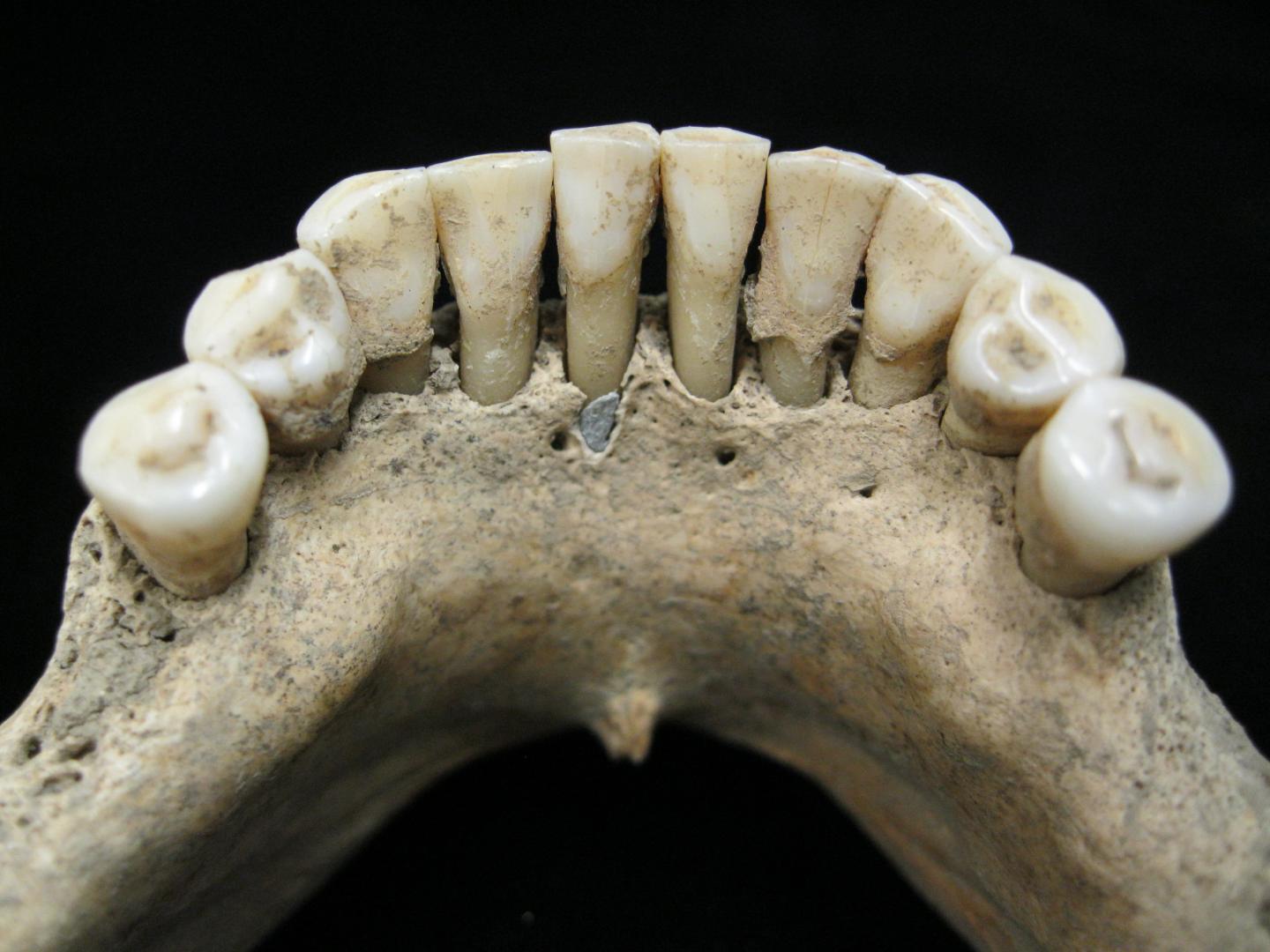
In a study published in Science Advances, an international team of researchers led by the Max Planck Institute for the Science of Human History and the University of York shed light on the role of women in the creation of such manuscripts with a surprising discovery–the identification of lapis lazuli pigment embedded in the calcified dental plaque of a middle-aged woman buried at a small women’s monastery in Germany around 1100 AD. Their analysis suggests that the woman was likely a painter of richly illuminated religious texts.
A quiet monastery in central Germany
As part of a study analyzing dental calculus – tooth tartar or dental plaque that fossilizes on the teeth during life – researchers examined the remains of individuals who were buried in a medieval cemetery associated with a women’s monastery at the site of Dalheim in Germany. Few records remain of the monastery and its exact founding date is not known, although a women’s community may have formed there as early as the 10th century AD. The earliest known written records from the monastery date to 1244 AD. The monastery is believed to have housed approximately 14 religious women from its founding until its destruction by fire following a series of 14th century battles.
One woman in the cemetery was found to have numerous flecks of blue pigment embedded within her dental calculus. She was 45-60 years old when she died around 1000-1200 AD. She had no particular skeletal pathologies, nor evidence of trauma or infection. The only remarkable aspect to her remains was the blue particles found in her teeth. “It came as a complete surprise – as the calculus dissolved, it released hundreds of tiny blue particles,” recalls co-first author Anita Radini of the University of York. Careful analysis using a number of different spectrographic methods – including energy dispersive X-ray spectroscopy (SEM-EDS) and micro-Raman spectroscopy – revealed the blue pigment to be made from lapis lazuli.
A pigment as rare and expensive as gold
“We examined many scenarios for how this mineral could have become embedded in the calculus on this woman’s teeth,” explains Radini. “Based on the distribution of the pigment in her mouth, we concluded that the most likely scenario was that she was herself painting with the pigment and licking the end of the brush while painting,” states co-first author Monica Tromp of the Max Planck Institute for the Science of Human History.
The use of ultramarine pigment made from lapis lazuli was reserved, along with gold and silver, for the most luxurious manuscripts. “Only scribes and painters of exceptional skill would have been entrusted with its use,” says Alison Beach of Ohio State University, a historian on the project.
The unexpected discovery of such a valuable pigment so early and in the mouth of an 11th century woman in rural Germany is unprecedented. While Germany is known to have been an active center of book production during this period, identifying the contributions of women has been particularly difficult. As a sign of humility, many medieval scribes and painters did not sign their work, a practice that especially applied to women. The low visibility of women’s labor in manuscript production has led many modern scholars to assume that women played little part in it.
The findings of this study not only challenge long-held beliefs in the field, they also uncover an individual life history. The woman’s remains were originally a relatively unremarkable find from a relatively unremarkable place, or so it seemed. But by using these techniques, the researchers were able to uncover a truly remarkable life history.
“She was plugged into a vast global commercial network stretching from the mines of Afghanistan to her community in medieval Germany through the trading metropolises of Islamic Egypt and Byzantine Constantinople. The growing economy of 11th century Europe fired demand for the precious and exquisite pigment that traveled thousands of miles via merchant caravan and ships to serve this woman artist’s creative ambition,” explains historian and co-author Michael McCormick of Harvard University.
“Here we have direct evidence of a woman, not just painting, but painting with a very rare and expensive pigment, and at a very out-of-the way place,” explains Christina Warinner of the Max Planck Institute for the Science of Human History, senior author on the paper. “This woman’s story could have remained hidden forever without the use of these techniques. It makes me wonder how many other artists we might find in medieval cemeteries – if we only look.”
______________________________

Dental calculus on the lower jaw of a medieval woman entrapped lapis lazuli pigment. Christina Warinner
______________________________

A magnified view of lapis lazuli particles embedded within medieval dental calculus. Monica Tromp
______________________________
Article Source: MAX PLANCK INSTITUTE FOR THE SCIENCE OF HUMAN HISTORY news release.
*A. Radini, M. Tromp, A. Beach, E. Tong, C. Speller, M. McCormick, J. V. Dudgeon, M. J. Collins, F. Rühli, R. Kröger, C. Warinner Medieval women’s early involvement in manuscript production suggested by lapis lazuli identification in dental calculus, Science Advances.
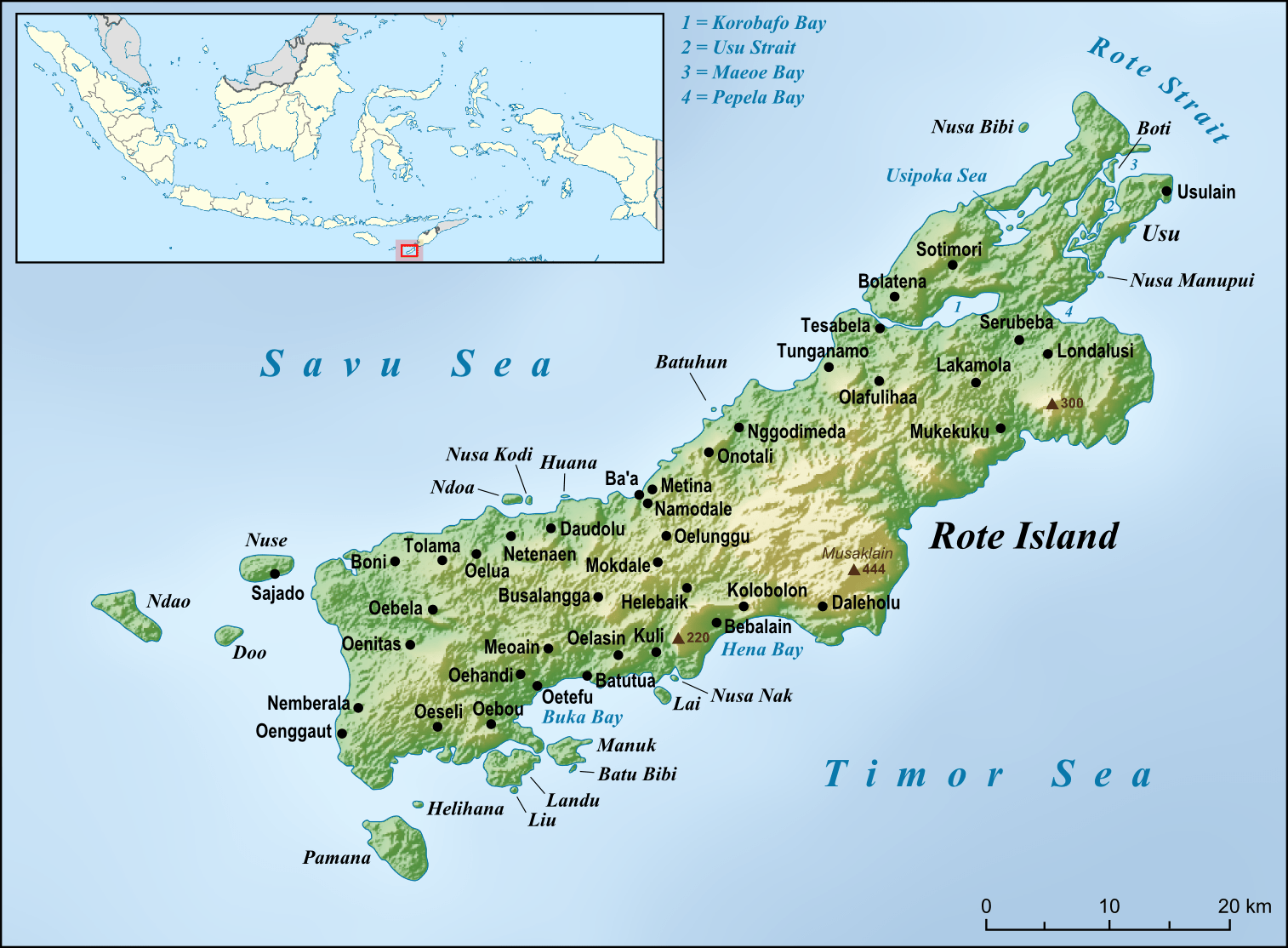
In an article to be published soon in Popular Archaeology Magazine, mariner-explorer and writer/historian Robert Hobman narrates in his own words his plans to traverse the waters of the Timor Sea from Indonesia to the coast of Australia in a sea-going vessel, or raft, fashioned according to what he and his team suggest was the technology available to prehistoric mariners tens of thousands of years ago.
Planned for February of 2020, the vessel will begin on Rote Island, an island of Indonesia and part of the East Nusa Tenggara province of the Lesser Sunda Islands. Rote lies 500 km (311 mi) northwest of the Australian coast and southwest of the larger island of Timor. To Rote’s immediate south is the Timor Sea, which is bounded in the north by the island of Timor, the east by the Arafura Sea, and the south by Australia.
Hobman hopes to replicate as much as possible the voyage he suggests ancient Pleistocene mariners made from Indonesia—which is part of the continent of Eurasia—to Australia, one of the first landforms of Oceania as one goes eastward.
“By at least 65,000 BC, so the latest archaeological clues tell us,” writes Hobman in the article, Homo sapiens “had discovered what is today known as Australia and began colonizing it. By 30,000 BC, according to the archaeological record, they had settled all the islands of Wallacea, the Philippines, and Melanesia of the Western Pacific……It is our hypothesis that these ancient ‘Wallaceans’ – there seems to be no contradicting theory – are the ancestors of the Melanesians and all the indigenous inhabitants of Sahul Land, the vast combined landmass of Papua New Guinea, Australia and Tasmania before the polar ice melted and the sea rose to terrestrially separate them.”
The raft will be constructed of locally available (and thought to have been available there in Pleistocene times) materials, such as bamboo, using stones tools and technology thought to have likely been used or at least available at the time. Food preparation and foodstuffs for the voyage will also be employed based on what the team suggests was likely in the area during prehistoric times.
“It will not be a drift voyage. Nor will it be a sailing venture, but something in between,” writes Hobman. “The raft’s crew will have paddles but also a great pile of palm leaves. As the first human conquerors of the Timor Sea would have done, some kind of basic sail must have been employed.”
Hobman believes that we have probably underestimated the capabilities and resolve of our prehistoric ancestors. “Humans are notoriously adept at exploiting nature to ease their burden,” he maintains. “…..even the earliest hominins were not stupid or suicidal enough to treat the oceans and enclosed seas……with anything but caution and a great deal of respect.”
His article will be available as a free premium article in the Winter 2019 Issue of Popular Archaeology Magazine.
_________________________________
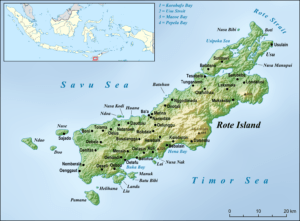
Map of Rote Island, from which Hobman and his crew will embark. Lencer, Wikimedia Commons
_________________________________
See, first-hand, the original fossils. See original artifacts. See the actual sites. Talk with the famous scientists. Join us on this unique specialized study tour.

BOSTON UNIVERSITY SCHOOL OF MEDICINE—During the Stone Age ancestral humans lived with a variety of animal species along what was an area of wetlands in the middle of the Jordanian desert. The site, in the town of Azraq Basin, has been excavated and has revealed an abundance of tools and animal bones from up to 250,000 years ago, leading to better understanding of how ancestral humans have adapted to this changing environment.
James Pokines, PhD, associate professor of forensic anthropology at Boston University School of Medicine, was a leader of the excavation with a team from the Azraq Marshes Archaeological and Paleoecological Project.
The team discovered bone and tooth specimens belonging to wild ancestors of modern-day camels and elephants, as well as horse, rhinoceros, antelope and wild cattle species, among others. Poor preservation of small and less dense bones has resulted in limited conclusions about smaller species of animals that may have inhabited the area during this time.
Prior research in the site revealed evidence of butchery, with blood proteins from multiple species appearing on Stone Age tools. “The periphery of the wetlands where large animals drank and grazed would have presented excellent hunting opportunities for ancestral humans. Humans may have also faced their own challenges from other predatory competitors such as lions and hyenas roaming the area,” said Pokines, corresponding author of the study.
The team’s discovery adds important background to a growing picture of land use over time in Azraq Basin. “There are many portions of the globe that we still know so little about in terms of how ancestral humans lived and evolved there and how they adapted to that environment … we hope to understand how different populations of ancestral humans adapted to this changing, arid environment throughout the Stone Age.”
The excavation efforts were the outcome of a successful collaboration with Jordanian authorities and according to the researchers has paved the way for future excavations in the region.
Article Source: Boston University School of Medicine news release
For more about the archaeological discoveries near Azraq, see the article, Archaeology team makes unprecedented tool discovery.
_____________________________________

A view of the current Azraq wetlands reserve. This wetlands area dates back as far as 250,000 years ago. Ldud, Wikimedia Commons
_____________________________________

Genomic analyses can reveal the geographic origins of indigenous Aboriginal Australian remains currently held in museums, a new study* reports. Critically, this could allow these remains to be returned to their original communities – a result Aboriginal Australians have fought to achieve for decades. According to the authors, their study has significant implications for future repatriation of ancient peoples, Aboriginal Australians and beyond. Indigenous peoples around the world have been greatly affected by European colonization. Since the arrival of the British to Australia in 1788, Aboriginal Australian remains have been collected for scientific research or for museums. Many indigenous people believe that their ancestors’ spirits cannot rest until their remains are returned to their ancestral lands, and thus, over many decades, Aboriginal Australians have requested that their ancestors’ remains be returned. Unfortunately, in most cases, the geographic origin, tribal affiliation, or language group of many of these remains, respectively, are unknown, thus preventing repatriation. Recent advances have suggested that genomic analyses could aid in repatriation, yet few genomic studies to date have attempted to recover ancient Aboriginal Australian DNA specifically, and none of them have been able to obtain and sequence nuclear DNA from this region, where the climate is harsh. To determine if genomic analyses can be used to successfully determine the origin of indigenous skeletal remains, Joanne L. Wright and colleagues obtained and sequenced ten nuclear genomes and 27 mitochondrial DNA genomes from pre-European Australian samples of known provenance. They compared these ancient samples to the nuclear genomes of 100 modern Aboriginal Australians also of known provenance. Their analysis showed that, for most all of the ancient nuclear genomes, the most closely related contemporary genome was from people living today in the same geographic region. Their results also suggest that mitochondrial sequences, if used in repatriation efforts in Australia, would result in a significant percentage (~7%) of remains being returned to the wrong Indigenous group. Thus, say the authors, mitochondrial DNA alone is not recommended for repatriation.
_________________________________

Willandra Lakes Region – World Heritage Site. Sherene Lambert
_________________________________

David Lambert and Willandra Elder Michael Young visiting the ancient DNA laboratory. Dr. Renee Chapman
_________________________________

Willandra Elders visiting the ancient DNA laboratory. Dr. Renee Chapman
_________________________________
*Article Source: Science Advances news release, published by AAAS, the nonprofit science society.
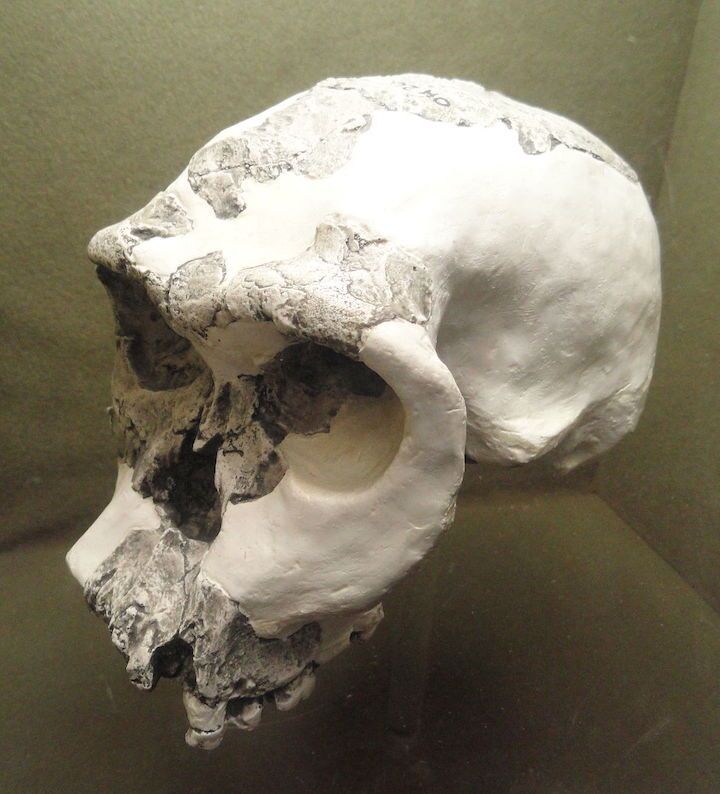
You can look long and hard, and you will not find a travel opportunity like this one anywhere. But now, finally, a unique educational travel experience has been designed for anyone with a special interest or passion for the field of human origins and human evolution. Called the Human Origins Field Seminar with [Smithsonian paleoanthropologist] Dr. Briana Pobiner, this is what you will experience:
— In one trip, we will take you across three different African countries to sites where scientific history was made, and is still being made, in cutting-edge research on human origins and human evolution. As such, you will be traveling across more terrain than typical of any standard Africa tour;
— You will meet with prominent, world-renowned scientists who are leading the way with new discoveries in human origins and human evolution;
— You will be given “back-door” special access to the fossil and artifact collections that have and are making scientific history in human evolution research;
— You will be traveling with a Smithsonian paleoanthropologist who has done significant field research in Africa and who will be with you the entire time for lectures, discussions, to lead you through the important sites, and to answer your questions;
— Along with all of this, you will have the opportunity to enjoy traveling and observing African wildlife, geography, and geology in three different countries, much of which had a bearing on the kind of environment in which early human ancestors lived;
— This may be the only chance you will have to experience an opportunity this unique, particularly as it may never be offered again.
For more information about this one-of-a-kind travel opportunity, go to the website at http://www.grouptoursite.com/tours/mclerran and join us for the trip of a lifetime!
Should you decide to join us, email me at populararchaeology@gmail.com and let us know you are interested, along with any questions you may have.
Your partner in travel,
Dan McLerran
Founder and Editor
Popular Archaeology Magazine
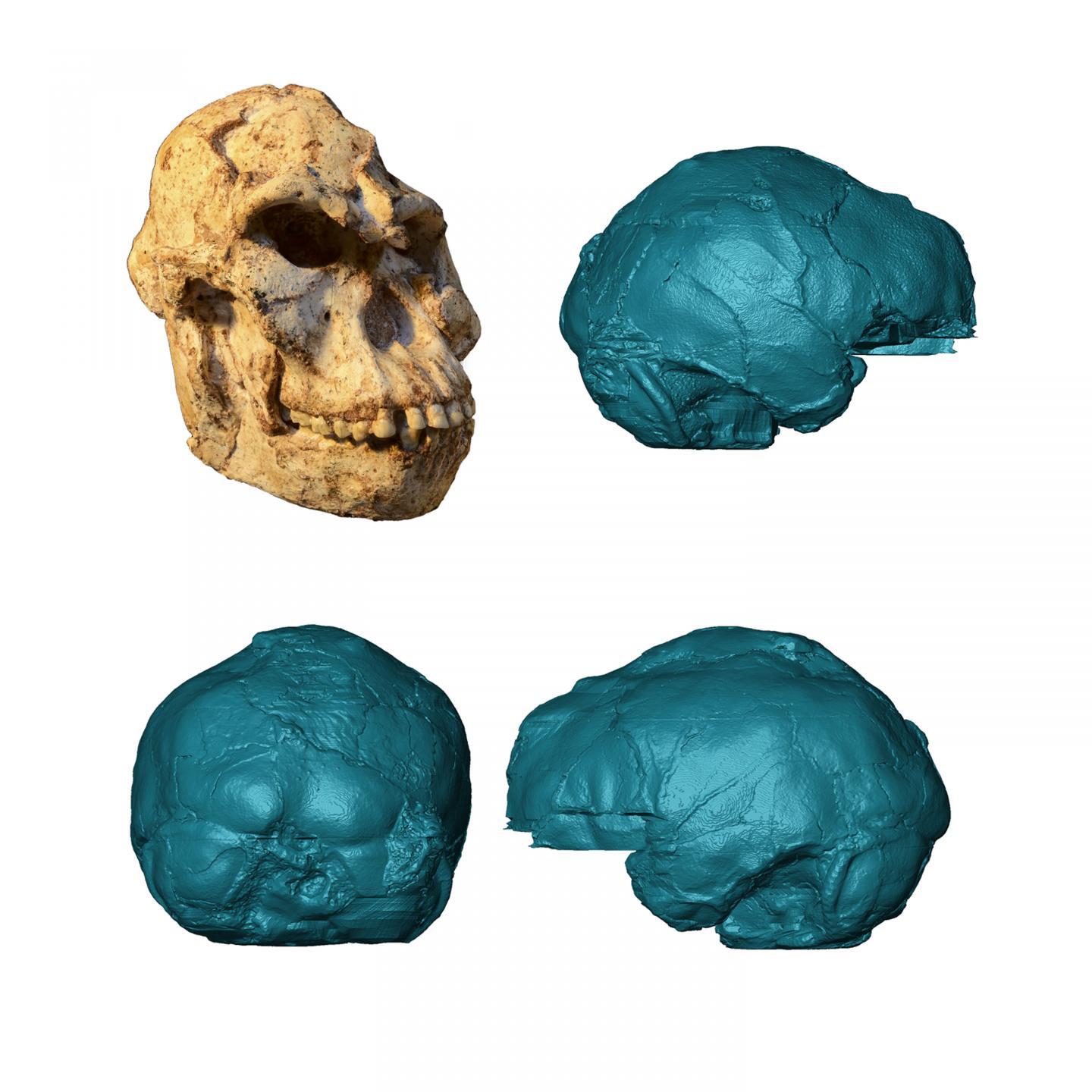
UNIVERSITY OF THE WITWATERSRAND—The first ever endocast reconstruction of the nearly complete brain of the hominin known as Little Foot reveals a small brain combining ape-like and human-like features.
MicroCT scans of the Australopithecus fossil known as Little Foot shows that the brain of this ancient human relative was small and shows features that are similar to our own brain and others that are closer to our ancestor shared with living chimpanzees.
While the brain features structures similar to modern humans – such as an asymmetrical structure and pattern of middle meningeal vessels – some of its critical areas such as an expanded visual cortex and reduced parietal association cortex points to a condition that is distinct from us.
The Australopithecus fossil named Little Foot, an ancient human relative, was excavated over 14 years from the Sterkfontein Caves in South Africa by Professor Ronald Clarke from the University of the Witwatersrand (Wits). Its brain endocast was virtually extracted, described and analyzed by Wits researcher, Dr Amélie Beaudet, and the Sterkfontein team by using MicroCT scans of the fossil.
The scans reveal impressions left on the skull by the brain and the vessels that feed it, along with the shape of the brain. Beaudet’s research was released as the first in a series of papers planned for a special issue of this journal on the near-complete “Little Foot” skeleton in the Journal of Human Evolution.
“Our ability to reconstruct features of early hominin brains has been limited by the very fragmentary nature of the fossil record. The Little Foot endocast is exceptionally well preserved and relatively complete, allowing us to explore our own origins better than ever before,” says Beaudet.
The endocast showed that Little Foot’s brain was asymmetrical, with a distinct left occipital petalia. Brain asymmetry is essential for lateralisation of brain function. Asymmetry occurs in humans and living apes, as well as in other younger hominin endocasts. Little Foot now shows us that this brain asymmetry was present at a very early date (from 3.67 million years ago), and supports suggestions that it was probably present in the last common ancestor of hominins and other great apes.
Other brain structures, such as an expanded visual cortex, suggests that the brain of Little Foot probably had some features that are closer to the ancestor we share with living chimpanzees.
“In human evolution, we know that a reduced visual cortex, as we can see in our own brain, is related to a more expanded parietal cortex – which is a critical cerebral area responsible for several aspects of sensory processing and sensorimotor integration,” says Beaudet. “On the contrary, Little Foot has a large visual cortex, which is more similar to chimpanzees than to humans.”
Beaudet and her colleagues compared the Little Foot endocast with endocasts of 10 other South African hominins dating between three and 1.5 million years ago. Their preliminary calculation of Little Foot’s endocranial volume was found to be at the low end of the range for Australopithecus, which is in keeping with its great age and its place among other very early fossils of Australopithecus from East Africa.
The study also has shown that the vascular system in Australopithecus was more complex than previously thought, which raises new questions on the metabolism of the brain at this time. This might be consistent with a previous hypothesis suggesting that the endocranial vascular system in Australopithecus was closer to modern humans than it was in the geologically younger Paranthropus genus.
“This would mean that even if Little Foot’s brain was different from us, the vascular system that allows for blood flow (which brings oxygen) and may control temperature in the brain – both essential aspects for evolving a large and complex brain – were possibly already present at that time,” says Beaudet.
Given its geological age of over 3 million years, Little Foot’s brain suggests that younger hominins evolved greater complexity in certain brain structures over time, perhaps in response to increasing environmental pressures experienced after 2.6 million years ago with continuing reduction of closed habitats.
“Such environmental changes could also potentially have encouraged more complex social interaction, which is driven by structures in the brain,” says Beaudet.
______________________________
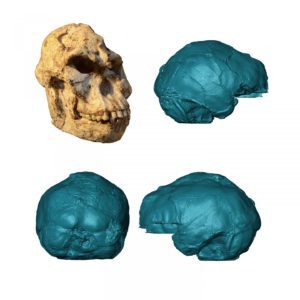
Above and below: Virtual rendering of the brain endocast of “Little Foot”. Photo of the original skull by M. Lotter and R.J. Clarke. Wits University
______________________________

______________________________
Article Source: University of the Witwatersrand news release
If you liked this article, you may like The Age of Little Foot, an in-depth premium article previously published in Popular Archaeology.
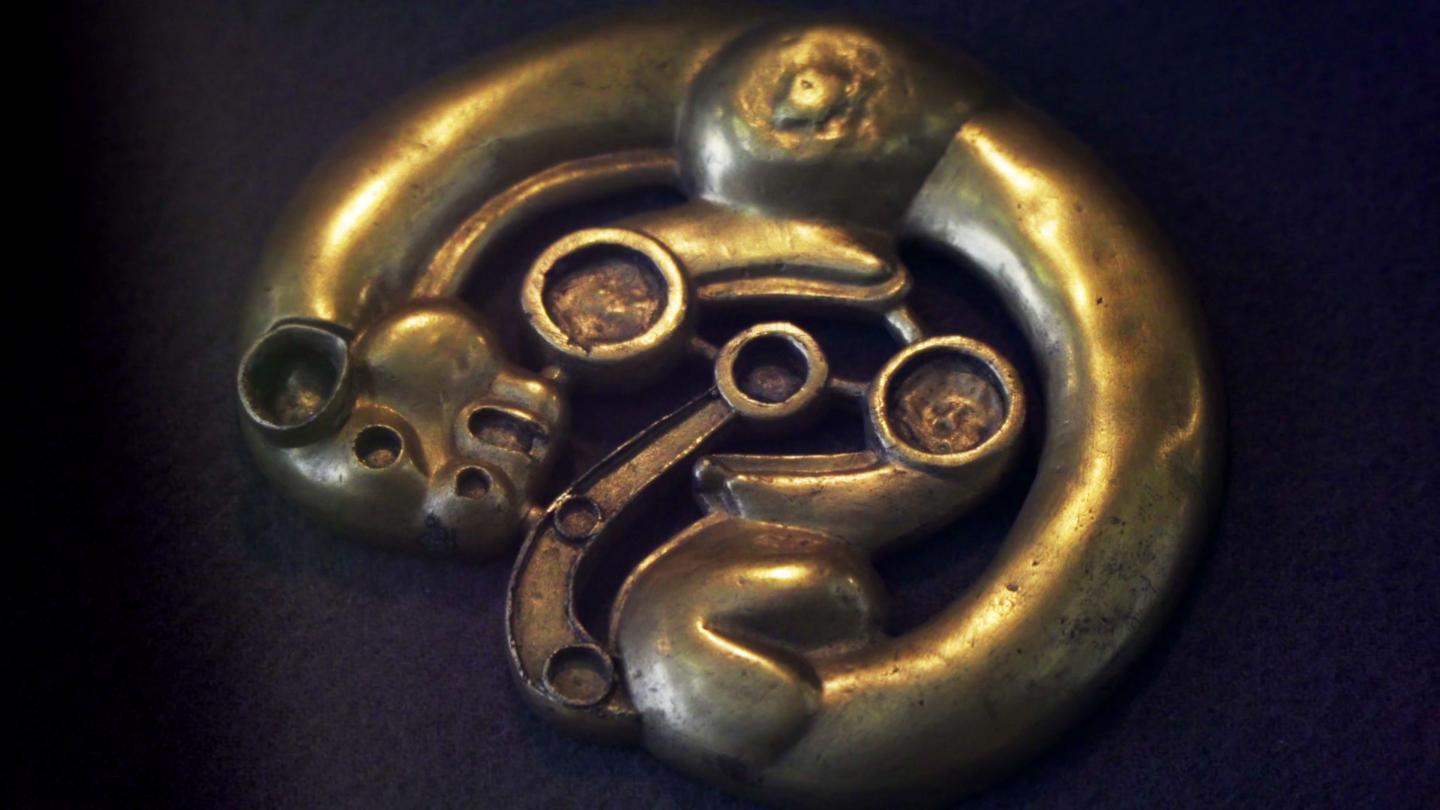
UNIVERSITY OF BERN—More than 2,500 years ago, horse riding nomads expanded their cultural realm throughout the Eurasian steppe from Southern Siberia to Eastern Europe. These tribes buried their dead in large burial mounds often together with elaborate golden jewelry and weapons of superior craftsmanship. Most of the organic materials are lost forever, but objects made from metals survive the millennia. Often made from bronze and gold, these treasures attract looters. During the colonization of Siberia in the 18th century, looting even became a seasonal job when gangs of diggers, sometimes up to 300 strong, excavated burials from spring to autumn each year. To transport the metals more easily, the prehistoric artworks were often melted down right at the site where they had been found.
Applying high-resolution satellite imagery
It has become increasingly difficult to find unlooted tombs. The prices for archaeological objects from these burials, however, have seen a vast increase. Gino Caspari from the Institute of Archaeological Sciences at the University of Bern analyzed the condition of burials in a difficult-to-access region based on high-resolution satellite imagery. These data help to assess the degree of destruction inflicted upon the archaeological heritage. “We specifically chose an area of interest in Xinjiang, China. We assumed that, due to the remoteness and the heavy presence of security forces in the region, we would find a higher proportion of intact tombs”, Caspari explains. However, this assumption proved to be wrong: “More than 74.5 percent of the analyzed burials were already destroyed and plundered”, says Caspari.
Archaeological sites severely threatened
Through conducting an on-ground survey, the researchers managed to show that high-resolution satellite imagery can provide an accurate measurement of the destruction at a particular site. Using time series of different datasets, looting can be effectively monitored. Caspari analyzed data going back to 2003, and found that since then the number of looted tombs increased substantially. “The last untouched archaeological sites of the ancient steppe nomads are under imminent threat”, says Caspari.
The research, published in the journal Heritage, allows for a consequent monitoring of archaeological heritage in remote regions of Central Asia. When looting at a site is recognized in an early stage, measures for the protection of the tombs can be put in place.
___________________________________
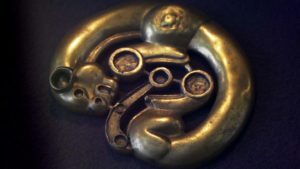
Prehistoric artwork found in early Iron Age tombs. Trevor Wallace
___________________________________
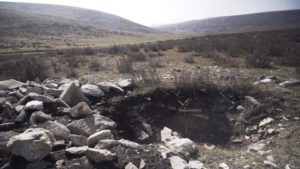
A recently looted tomb in Northwest China. Trevor Wallace
___________________________________
Article Source: University of Bern news release
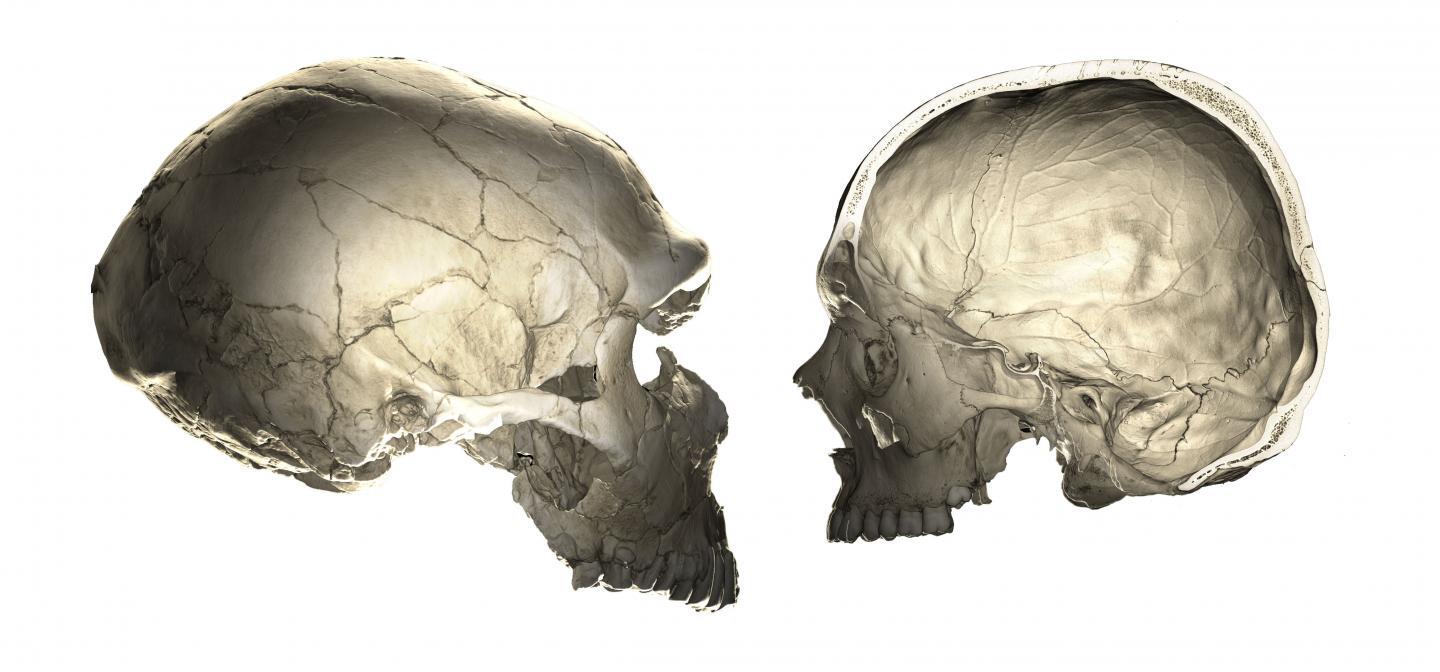
CELL PRESS—A distinctive feature of modern humans is our round (globular) skulls and brains. On December 13, in the journal Current Biology, researchers report that present-day humans who carry particular Neanderthal DNA fragments have heads that are slightly less rounded, revealing genetic clues to the evolution of modern brain shape and function.
“We captured subtle variations in endocranial shape that likely reflect changes in the volume and connectivity of certain brain areas,” says Philipp Gunz, a paleoanthropologist at the Max Planck Institute for Evolutionary Anthropology, who co-led the study with Amanda Tilot of the Max Planck Institute for Psycholinguistics.
“Our aim was to identify potential candidate genes and biological pathways that are related to brain globularity,” says Amanda Tilot.
To tightly focus their search, they took advantage of the fact that living humans with European ancestry carry rare fragments of Neanderthal DNA buried in their genomes, as a result of interbreeding between Neanderthals and the ancestors of modern Europeans. Different people carry different fragments, which are scattered through the genome.
Gunz, Tilot, and colleagues analyzed cranial shape and identified stretches of Neanderthal DNA in a large sample of modern humans, relying on MRI brain scans and genetic information for about 4,500 people. Based on computed tomographic scans, they computed the endocranial shape differences between Neanderthal fossils and modern human skulls. They used this contrast to assess endocranial shape in thousands of MRI brain scans of living people.
They used information from sequenced genomes of ancient Neanderthal DNA to identify Neanderthal DNA fragments in living humans on chromosomes 1 and 18 that correlated with reduced cranial roundness. These fragments contained two genes already linked to brain development: UBR4, involved in the generation of neurons, and PHLPP1, involved in the development of myelin insulation around nerve cell projections.
“We know from other studies that completely disrupting UBR4 or PHLPP1 can have major consequences for brain development,” says senior author Simon Fisher (@ProfSimonFisher), a geneticist at the Max Planck Institute for Psycholinguistics. “Here we found that, in carriers of the relevant Neanderthal fragment, UBR4 is slightly down-regulated in the putamen. For carriers of the Neanderthal PHLPP1 fragment, gene expression is slightly higher in the cerebellum, which would be predicted to have a dampening effect on cerebellar myelination.”
The putamen—part of a network of brain structures called the basal ganglia—and the cerebellum are thought to be important in movement.
“Both brain regions receive direct input from the motor cortex and are involved in the preparation, learning, and sensorimotor coordination of movements,” says Gunz. “The basal ganglia also contribute to diverse cognitive functions, in memory, attention, planning, skill learning, and potentially speech and language evolution.”
The researchers stress that the effects of carrying these rare Neanderthal fragments are subtle and only detectable in a very large sample size.
“The Neanderthal variants lead to small changes in gene activity and only push people slightly towards a less globular brain shape,” says Fisher. “This is just our first glimpse of the molecular underpinnings of this phenotype, which is likely to involve many other genes.”
The researchers are preparing to scale up their approach and apply it to tens of thousands of people. That will enable them to carry out a fully genome-wide screen to reveal additional genes associated with cranial roundness and other biological characteristics.
“The interdisciplinary approach that we developed for this study could be applied more broadly to unresolved questions about human brain evolution,” says Fisher.
________________________________
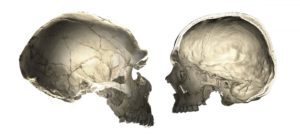
This image shows that one of the features that distinguishes modern humans (right) from Neanderthals (left) is a globular shape of the braincase. Philipp Gunz (CC BY-NC-ND 4.0)
________________________________
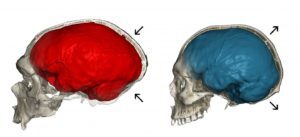
This image shows a CT scan of the Neanderthal fossil (left) with a typical elongated endocranial imprint (red) and a CT scan of a modern human (right) showing the characteristic globular endocranial shape (blue). Philipp Gunz, CC BY-NC-ND 4.0
________________________________
Article Source: Cell Press news release
*Gunz et al.: “Neandertal introgression sheds light on modern human endocranial globularity” https://www.cell.com/current-biology/fulltext/S0960-9822(18)31470-2

BIOMED CENTRAL—Part of the ancient archaeological site of Tiwanaku, Bolivia, believed by Incans to be where the world was created has been reconstructed using 3D printed models of fragments of an ancient building. The results are presented in a study* published in the open access journal Heritage Science.
Researchers at UC Berkeley, USA, created accurate, 3D-printed miniature models of architectural fragments to reconstruct the Pumapunku building in the Tiwanaku site. Considered to be an architectural wonder of its time (AD 500-950), Pumapunku has been ransacked over the last 500 years to a point where none of the remaining 150 blocks that comprised the original building remain in their original place.
Dr Alexei Vranich, the corresponding author said: “A major challenge here is that the majority of the stones of Pumapunku are too large to move and that field notes from previous research by others present us with complex and cumbersome data that is difficult to visualize. The intent of our project was to translate that data into something that both our hands and our minds could grasp. Printing miniature 3D models of the stones allowed us to quickly handle and refit the blocks to try and recreate the structure.
“It is possible that using 3D printed models of fragments could help the study of other historic sites that have fallen apart in time, such as Angkor Wat in Cambodia, or that have been the victim of recent destruction, such as Palmyra in Syria. “
The 3D reconstruction of Pumapunku not only shows possible configurations of what the site may have looked like, but also gives clues about the purpose of the building.
Dr Vranich said: “One particularly interesting realization was that smashed doorways of different sizes that lay scattered around the site were aligned in a manner that would create a “mirror” effect; the impression of looking into infinity, when, in fact, the viewer was looking into a single room. This may relate to the Incans belief that this is the site where the world was created and could also suggest that the building was used as a ritual space.”
The authors printed 3D models of a total of 140 pieces of andesite and 17 slabs of sandstone based on measurements compiled by various scholars over the past century and a half of the height, length and width of the blocks found at the site of Tiwanaku. Once modelled on the computer and then made solid with a 3d printer, the authors then physically manipulated the blocks to reconstruct the site, trying out different ways in which they may fit together.
Dr Vranich said: “This effort represents a technological step back from recent methods that used computer modelling to recreate structures on screen, but the human brain continues to be more efficient than a computer when it comes to manipulating and visualizing irregular 3D forms. We attempted to capitalize on archaeologists’ learned ability to visualize and mentally rotate irregular objects in space by providing them with 3D printed objects that they could physically manipulate.”
_________________________________

3D printed model of the ancient site of Tiwanaku. Dr Alexei Vranich, 2018
_________________________________

3D printed model of Pumapunku. Dr Alexei Vranich, 2018
_________________________________
Article Source: Biomed Central news release
*Reconstructing ancient architecture at Tiwanaku, Bolivia: the potential and promise of 3D printing
Vranich, Heritage Science 2018 DOI: 10.1186/s40494-018-0231-0
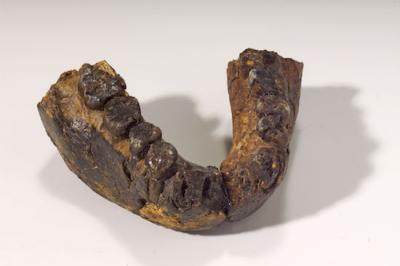
_______________________________
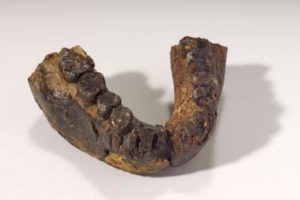
Fossil tooth enamel of Homo rudolfensis has been analyzed to reconstruct its diet. Image courtesy of Oliver Sandrock.
_______________________________
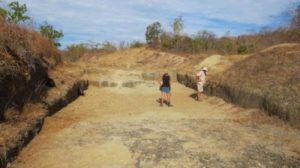
Researcher investigating ancient soils at the Paranthropus boisei fossil site in the Malawi Rift. Image courtesy of Tina Lüdecke.
_______________________________
Article Source: PNAS news release
*“Dietary versatility of Early Pleistocene hominins,” by Tina Ludecke et al.
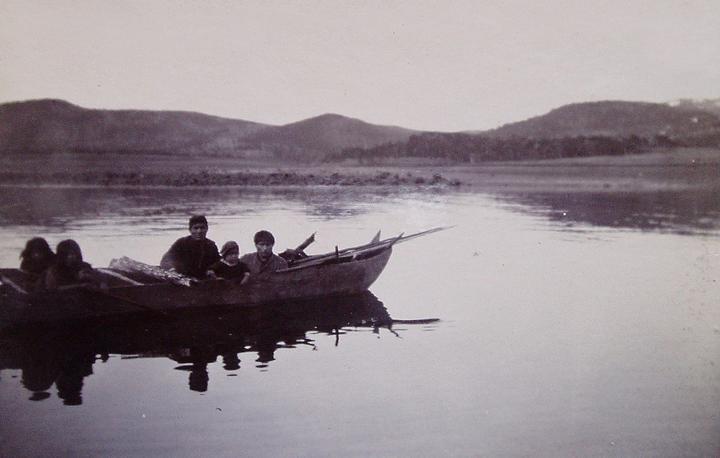
FECYT – SPANISH FOUNDATION FOR SCIENCE AND TECHNOLOGY—Argentine and Spanish researchers have used statistical techniques of automatic learning to analyze mobility patterns and technology of the hunter-gatherer groups that inhabited the Southern Cone of America, from the time they arrived about 12,000 years ago until the end of the 19th century. Big data from archaeological sites located in the extreme south of Patagonia have been used for this study*.
The presence of humans on the American continent dates back to at least 14,500 years ago, according to datings made at archaeological sites such as Monte Verde, in Chile’s Los Lagos Region. But the first settlers continued moving towards the southernmost confines of America.
Now, researchers from Argentina’s National Council for Scientific and Technical Research (CONICET) and two Spanish institutions (the Spanish National Research Council and the University of Burgos) have analyzed the relationships between mobility and technology developed by those societies that originated in the far south of Patagonia.
The study, published in the Royal Society Open Science journal, is based on an extensive database of all available archaeological evidence of human presence in this region, from the time the first groups arrived in the early Holocene (12,000 years ago) until the end of the 19th century.
This was followed by the application of machine learning techniques, a statistical system that allows the computer to learn from many data (in this case, big data from characteristic technological elements of the sites) in order to carry out classifications and predictions.
“It is by means of automatic classification algorithms that we have identified two technological packages or ‘landscapes’: one that characterizes pedestrian hunter-gatherer groups (with their own stone and bone tools) and the other characterizing those that had nautical technology, such as canoes, harpoons and mollusc shells used to make beads,” explains Ivan Briz i Godino, an archaeologist of the National Council for Scientific and Technical Research (CONICET) of Argentina and co-author of the work.
“In future excavations, when sets of technological elements such as those we have detected appear, we’ll be able to directly deduce the type of mobility of the group or the connections with other communities,” adds Briz.
The results of the study have also made it possible to obtain maps with the settlements of the two communities, and this, in turn, has made it possible to locate large regions in which they interacted and shared their technological knowledge. In the case of groups with nautical technology, it has been confirmed that they arrived at around the beginning of the Mid-Holocene (some 6,000 years ago) from the channels and islands of the South Pacific, moving along the coast of what is now Chile.
“Traditional archaeology identifies sites, societies and their possible contacts on the basis of specific elements selected by specialists (such as designs of weapon tips or decorative elements), but here we show that it is more interesting to analyse sets of technological elements as a whole, using artificial intelligence techniques that allow us to work with large data volumes and without subjective prejudices,” concludes Briz.
_______________________________
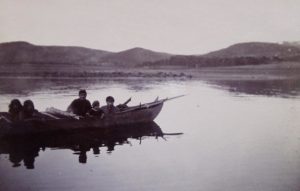
Example of a group with nautical technology: Yámana people in the Anglican mission of Bahía Tekenika (Tierra del Fuego), portrayed in the late 19th or early 20th century. Darwin lived with them during the second voyage of the Beagle. Ivan Briz i Godino courtesy of the archives of the South American Missionary Society (United Kingdom)
_______________________________

Selk’nam people, an example of a more pedestrian group, without nautical technology, although the marine resources were intensely exploited by those who lived near the coast. C. W. Furlong (January 1908) courtesy of the End of the World Museum (Ushuaia, Argentina).
_______________________________

Technological landscapes of nautical mobility (red circles, with some blues that are less well classified by the algorithm) and pedestrian mobility (orange and purple circles) in hunter-gatherer groups that lived in the extreme south of South America. Briz et al. 2018 / Royal Society Open Science
_______________________________
Article Source: FECYT – SPANISH FOUNDATION FOR SCIENCE AND TECHNOLOGY news release
*Ivan Briz i Godino, Virginia Ahedo, Myrian Álvarez, Nélida Pal, Lucas Turnes, José Ignacio Santos, Débora Zurro, Jorge Caro and José Manuel Galán. “Hunter – gatherer mobility and technological landscapes in southernmost South America: a statistical learning approach”. Royal Society Open Science, October 2018..
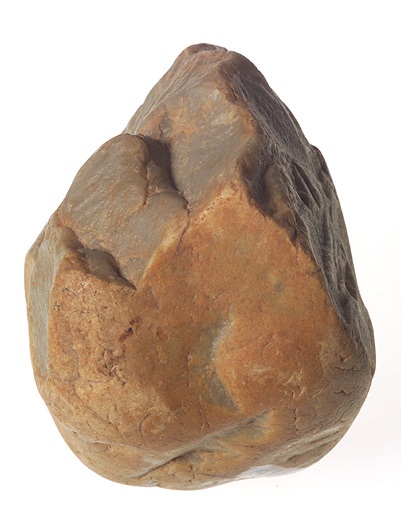
___________________________________

Stone chopper tool typical of the Oldowan tradition.
___________________________________
Article Source: American Association for the Advancement of Science news release

Perched atop the Tibetan Plateau – nearly 15,000 feet above sea level – researchers have discovered evidence of the earliest known, highest-altitude human occupation. According to their new study, the site Newa Devu, which was occupied at least 30,000 years ago, is the highest Paleolithic archaeological site yet identified and provides new insight into high-altitude (>4,000 meters above sea level) adaptation, as well as to modern human’s colonization of Earth’s highest reaches. Because of the unforgiving environments and the demanding biological adaptations required to survive them, early human occupation of high-altitude regions, like the Tibetan Plateau – one of the highest ever occupied – has been of great interest. Due to the lack of concrete evidence indicating the antiquity of the region’s earliest residents, however, the timing and processes that brought people to inhabit the “roof of the world” are not well-understood. As a result, some conclude that occupation occurred recently, near the onset of the Holocene, about 11,000 years ago. Xiaoling Zhang and colleagues report on new data from a well-preserved Paleolithic site situated at 4,600 meters above sea level with occupation beginning 30,000 to 40,000 years ago. According to Zhang et al., Newa Devu is characterized by a wide range of stone artifacts including advanced lithic blades that together suggest that the site was used as a workshop where tools were manufactured. Scant sites with similar stone technologies are found in North China, which according to the authors, suggest that early Tibetans interacted with contemporaries from Siberia and Mongolia. Furthermore, the results support the idea that hypoxia-reducing genes, obtained by infusion of Denisovan DNA, enhanced early settler’s ability to adapt to high-altitude extreme environments.
_______________________________
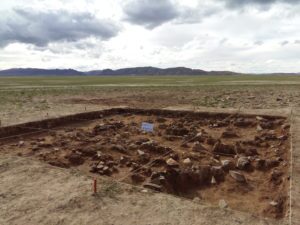
Excavation site on the Tibetan Plateau. Yingshuai Jin
_______________________________
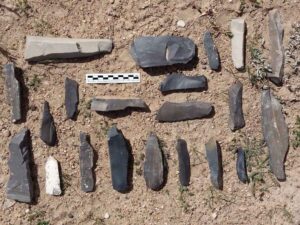
Artifacts found at the archaeological site. Xing Gao
_______________________________
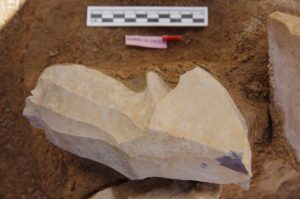
An unearthed bladecore from the excavation. Yingshuai Jin
_______________________________
If you liked this article, you may like On the Roof of the World: Discovering the Forgotten Civilization of Zhang Zhung, a premium article (now free) published previously by Popular Archaeology.
Article Source: AAAS news release. This research appears in the 30 November 2018 issue of Science. Science is published by AAAS, the nonprofit science society.
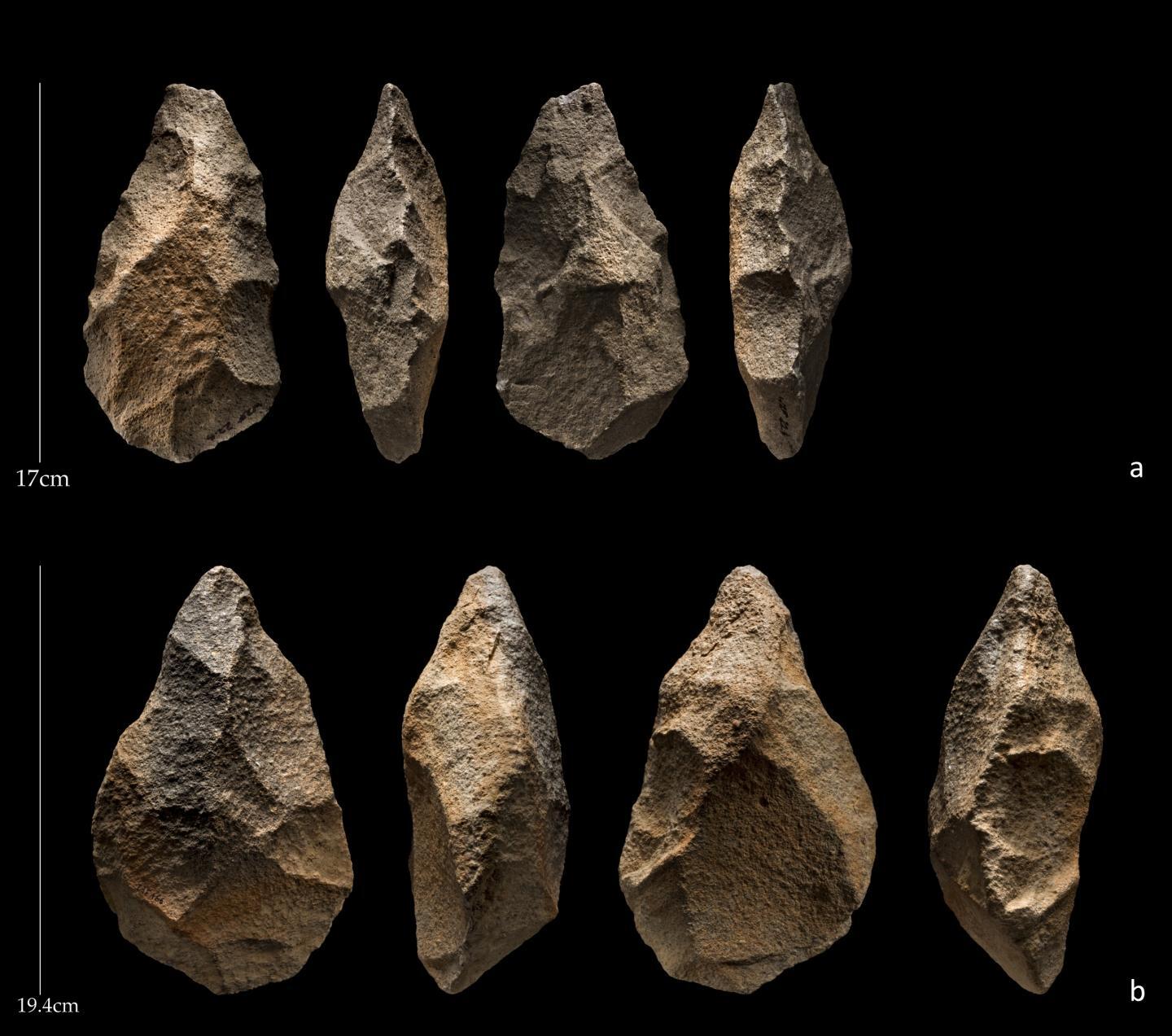
MAX PLANCK INSTITUTE FOR THE SCIENCE OF HUMAN HISTORY—Beginning more than 1.5 million years ago, early humans made stone handaxes in a style known as the Acheulean – the longest lasting tool-making tradition in prehistory. New research led by the Max Planck Institute for the Science of Human History and the Saudi Commission for Tourism and National Heritage has documented an Acheulean presence in the Arabian Peninsula dating to less than 190,000 years ago, revealing that the Arabian Acheulean ended just before or at the same time as the earliest Homo sapiens dispersals into the region.
Much attention has been given to understanding the spread of our own species, Homo sapiens, first within Africa and then beyond. However, less attention has been given to where diverse groups of close evolutionary cousins lived in Eurasia immediately prior to the arrival of Homo sapiens. Understanding this is critical because the spatial and temporal characteristics of such groups reveal the human and cultural landscape first encountered by our species on leaving Africa.
The youngest Acheulean site in Southwest Asia
In a paper published in Scientific Reports, an international team of researchers led by the Max Planck Institute for the Science of Human History and the Saudi Commission for Tourism and National Heritage reports the first ever dates obtained from an Acheulean site in Arabia, the site of Saffaqah, situated in Central Saudi Arabia. Saffaqah is the first stratified Acheulean site to be reported in the Arabian Peninsula and the dates reveal that early humans occupied the site until at least 190,000 years ago. These dates are surprisingly recent for a region known to feature among the oldest examples of such technology outside Africa. For example, dates from the Levant document an ancient Acheulean presence from 1.5 million years ago. Conversely the site of Saffaqah features the youngest Acheulean tools yet found in southwest Asia.
Over 500 stone tools, including handaxes and other artifacts known as cleavers, were recovered from the occupation levels. Some of the stone flakes used to make handaxes were in such fresh condition that they were recovered still resting on the stone nodules from which they had been detached. These and other artifacts show that the early humans responsible for making them were manufacturing stone tools at this site.
“It is not surprising that early humans came here to make stone tools,” says Dr. Eleanor Scerri of the Max Planck Institute for the Science of Human History, the lead author of the study. “The site is located on a prominent andesite dyke that rises above the surrounding plain. The spot was both a source of raw material as well as a prime location to survey a landscape that, back then, sat between two major river systems.” This choice location also seems to have continued to be attractive to early humans at an even later date than those recorded by the researchers in this study. Layers containing identical stone handaxes are also found above the dense occupation layers that were dated, raising the possibility that Saffaqah is among the youngest Acheulean sites documented anywhere.
Hominins living at the edge
The new dating results both record the late persistence of the Acheulean in the Peninsula and also show that as yet unidentified hominin populations were using networks of now extinct rivers to disperse into the heart of Arabia during a time of increased rainfall in the region. This suggests that these hominins were able to live on the margins of habitable zones and take advantage of relatively brief “greening” episodes in a generally arid area. The dispersal of these hominins into the heart of Arabia may also help to explain the surprisingly late persistence of the Acheulean, as it suggests a degree of isolation.
“These hominins were resourceful and intelligent,” adds Dr. Scerri, “They dispersed across a challenging landscape using technology commonly seen as reflecting a lack of inventiveness and creativity. Instead of perceiving the Acheulean this way, we should really be struck by how flexible, versatile and successful this technology was.”
Cutting edge science
To date the sediments from the site of Saffaqah, the researchers used a combination of dating techniques known as luminescence methods, including a newly developed infrared-radiofluorescence (IR-RF) dating protocol for potassium rich feldspars. The method relies on the ability of such minerals to store energy induced by natural radioactivity and to release this energy in the form of light. “The application of IR-RF dating allowed us to obtain age estimates from sediments that were previously difficult to reliably date,” explains Marine Frouin of the University of Oxford, one of the researchers involved in the dating program.
These discoveries and methods are already leading to new research. “One of the biggest questions we have is whether any of our evolutionary ancestors and close cousins met up with Homo sapiens, and if this could have happened somewhere in Saudi Arabia. Future field work will be dedicated to understanding possible cultural and biological exchanges at this critical time period,” says Professor Michael Petraglia of the Max Planck Institute for the Science of Human History, the director of the project which led to the discoveries at Saffaqah.
_________________________________

Handaxes from the site of Saffaqah, Saudi Arabia. Palaeodeserts (Ian R. Cartwright)
_________________________________
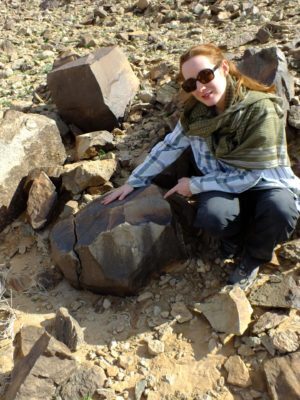
Researcher Eleanor Scerri with giant Acheulean core from which flakes were struck to create the handaxes. Palaeodeserts
_________________________________
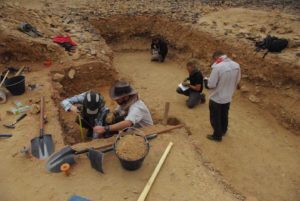
Archaeologists excavating the site of Saffaqah, Saudi Arabia. Palaeodeserts
_________________________________
Article Source: MAX PLANCK INSTITUTE FOR THE SCIENCE OF HUMAN HISTORY news release
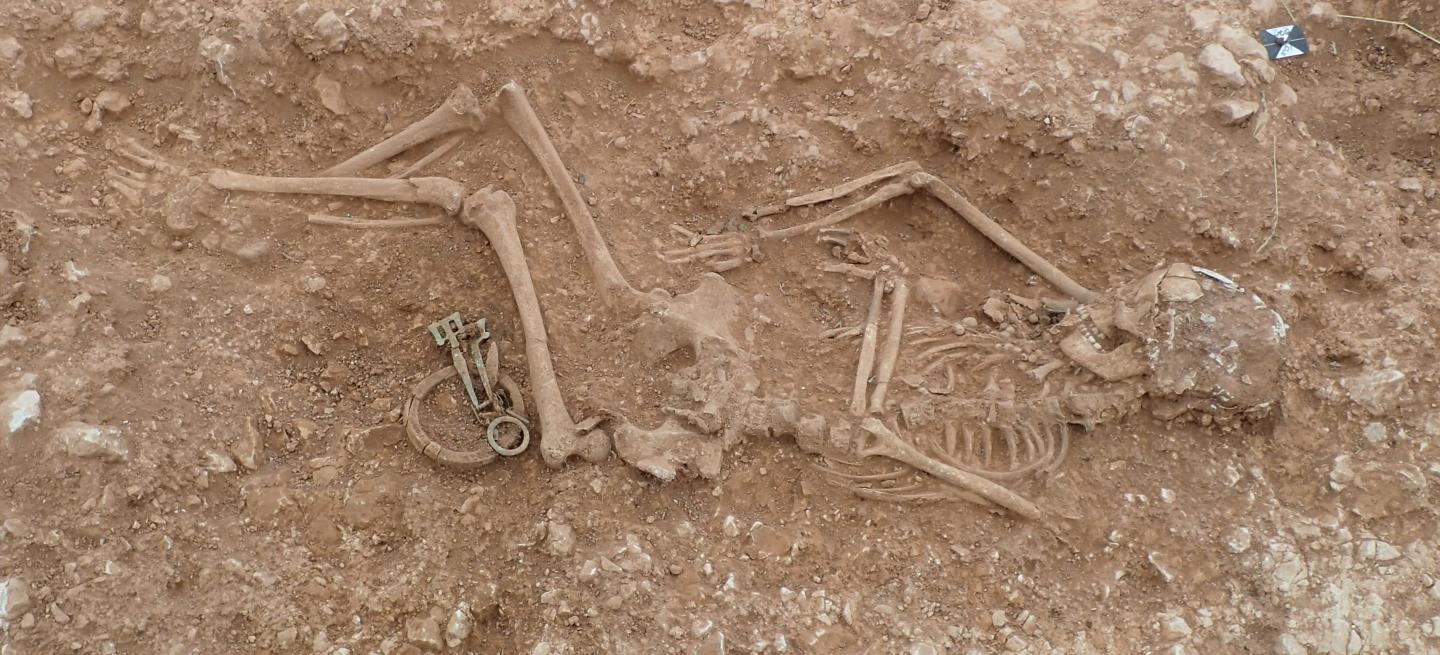
Excavations have revealed more than 20 burials at the extraordinary cemetery in the Lincolnshire Wolds dating back to the late fifth to mid sixth centuries AD.
The dig at the site in Scremby, Lincolnshire was led by Dr Hugh Willmott and Dr Katie Hemer from the University of Sheffield’s Department of Archaeology in collaboration with Dr Adam Daubney, the Lincolnshire Finds Liaison Officer for the Portable Antiquities Scheme.
The cemetery was first brought to light when a local metal detectorist began to discover a number of Anglo-Saxon artefacts, including copper gilded brooches, iron shield bosses and spear heads.
The finds were typical of those found in early Anglo-Saxon burials therefore it was necessary to excavate the site to ensure any further artifacts were retrieved, recorded and preserved before they could be destroyed by agricultural activity.
International volunteers, students from the University of Sheffield, and members of the RAF from nearby stations took part in the excavation which is the first to have been extensively investigated since the 19th century.
Dr Hugh Willmott, Senior Lecturer in European Historical Archaeology from the University of Sheffield, said: “Almost without exception, the burials were accompanied by a rich array of objects, in keeping with the funerary rites adopted during the early centuries of the Germanic migrations to eastern England.
“What is particularly interesting is the significant proportion of very lavish burials which belonged to women. These women wore necklaces made from sometimes hundreds of amber, glass and rock crystal beads, used personal items such as tweezers, carried fabric bags held open by elephant ivory rings, and wore exquisitely decorated brooches to fasten their clothing.
“Two women even received silver finger rings and a style of silver buckle commonly associated with Jutish communities in Kent. Furnished burials belonging to males were also identified, including a number buried with weaponry such as spears and shields.
Dr Willmott added: “Children were notably absent in the parts of the cemetery excavated this year, however, one of the most striking burials was that of a richly-dressed woman who was buried with a baby cradled in her left arm.
“The preservation of the skeletal remains, as well as the many grave finds, provide an exciting opportunity to explore the social and cultural dynamics of the community who chose to bury their dead on this chalky outcrop.”
In order to understand as much as possible about the site and those buried there, a series of scientific investigations are underway at the University of Sheffield by the Department of Archaeology.
The human remains are undergoing a complete osteological assessment, whilst stable isotope analysis of teeth and bone will identify where the individuals grew up as children and what food resources they ate.
Dr Katie Hemer, Lecturer in Bioarchaeology at the University of Sheffield, said: “Analysis also extends to a number of the finds, including the amber beads, which are being provenanced in collaboration with colleagues from Sheffield’s Department of Physics; we will analyze the elemental composition of the metalwork and identify the elephant species which produced the ivory rings.
“The project’s multi-faceted investigation which incorporates cutting-edge scientific techniques will enable Sheffield archaeologists to ask and answer significant questions about early Anglo-Saxon communities in eastern England.”
_______________________________
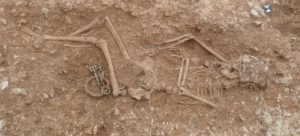
This is a female burial unearthed at the Anglo-Saxon cemetery in Lincolnshire. University of Sheffield
_______________________________
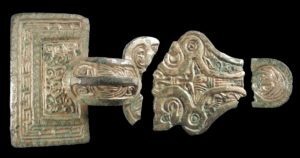
This is a brooch found at the Anglo-Saxon cemetery unearthed by archaeologists from the University of Sheffield. University of Sheffield
_______________________________
Article Source: University of Sheffield news release
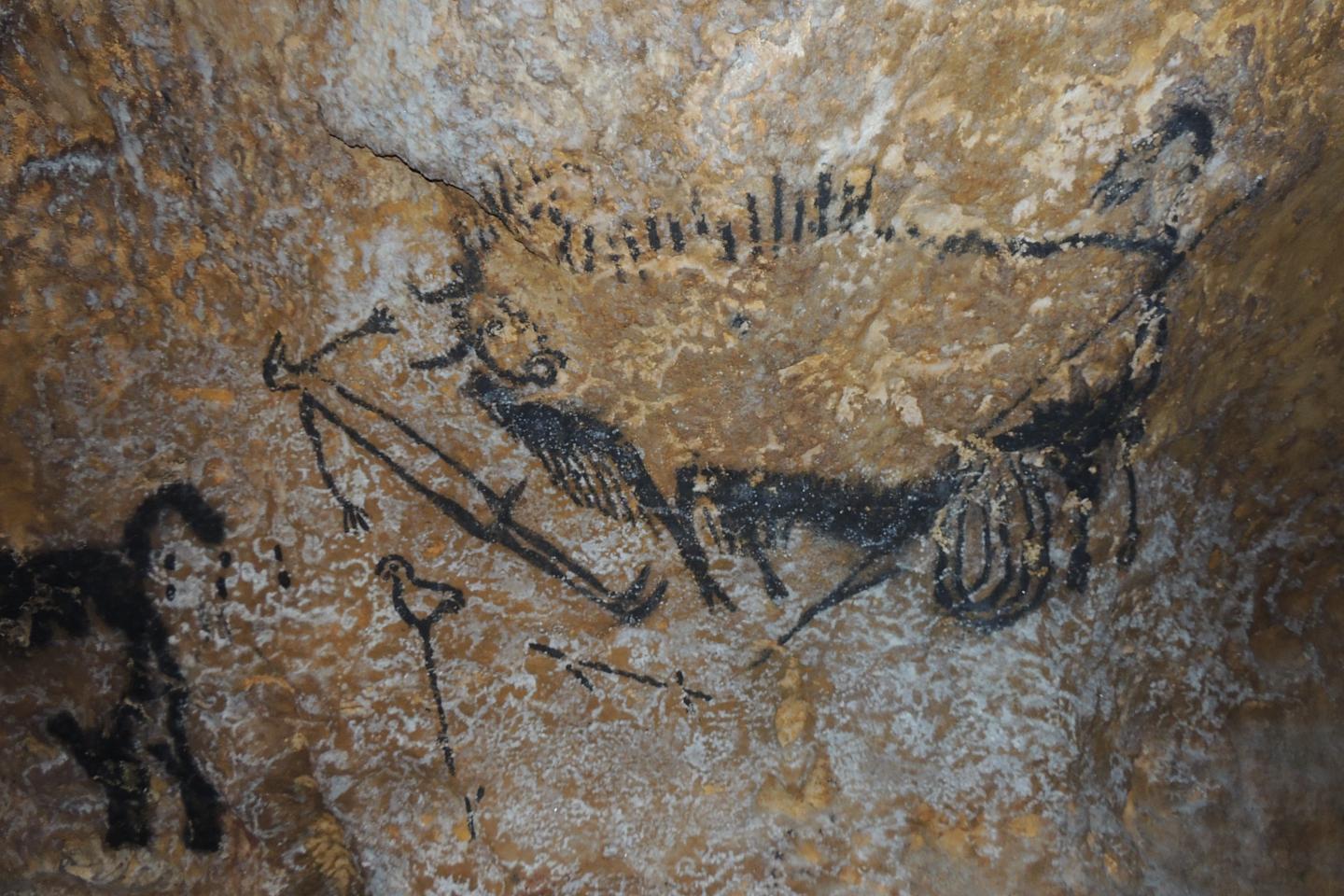
UNIVERSITY OF EDINBURGH—Some of the world’s oldest cave paintings have revealed how ancient people had relatively advanced knowledge of astronomy.
The artworks, at sites across Europe, are not simply depictions of wild animals, as was previously thought. Instead, the animal symbols represent star constellations in the night sky, and are used to represent dates and mark events such as comet strikes, analysis suggests.
They reveal that, perhaps as far back as 40,000 years ago, humans kept track of time using knowledge of how the position of the stars slowly changes over thousands of years.
The findings suggest that ancient people understood an effect caused by the gradual shift of Earth’s rotational axis. Discovery of this phenomenon, called precession of the equinoxes, was previously credited to the ancient Greeks.
Around the time that Neanderthals became extinct, and perhaps before mankind settled in Western Europe, people could define dates to within 250 years, the study shows.
The findings indicate that the astronomical insights of ancient people were far greater than previously believed. Their knowledge may have aided navigation of the open seas, with implications for our understanding of prehistoric human migration.
Researchers from the Universities of Edinburgh and Kent studied details of Palaeolithic and Neolithic art featuring animal symbols at sites in Turkey, Spain, France and Germany.
They found all the sites used the same method of date-keeping based on sophisticated astronomy, even though the art was separated in time by tens of thousands of years.
Researchers clarified earlier findings from a study of stone carvings at one of these sites – Gobekli Tepe in modern-day Turkey – which is interpreted as a memorial to a devastating comet strike around 11,000 BC. This strike was thought to have initiated a mini ice-age known as the Younger Dryas period.
They also decoded what is probably the best known ancient artwork – the Lascaux Shaft Scene in France. The work, which features a dying man and several animals, may commemorate another comet strike around 15,200 BC, researchers suggest.
The team confirmed their findings by comparing the age of many examples of cave art – known from chemically dating the paints used – with the positions of stars in ancient times as predicted by sophisticated software.
The world’s oldest sculpture, the Lion-Man of Hohlenstein-Stadel Cave, from 38,000 BC, was also found to conform to this ancient time-keeping system.
This study was published in Athens Journal of History.
Dr Martin Sweatman, of the University of Edinburgh’s School of Engineering, who led the study, said: “Early cave art shows that people had advanced knowledge of the night sky within the last ice age. Intellectually, they were hardly any different to us today.
“These findings support a theory of multiple comet impacts over the course of human development, and will probably revolutionize how prehistoric populations are seen.”
_____________________________
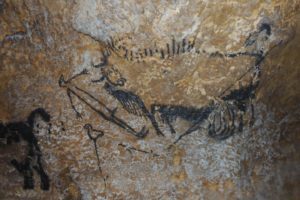
Some of the world’s oldest cave paintings have revealed how ancient people had relatively advanced knowledge of astronomy. Animal symbols represent star constellations in the night sky, and are used to mark dates and events such as comet strikes, analysis from the University of Edinburgh suggests. Alistair Coombs
_____________________________
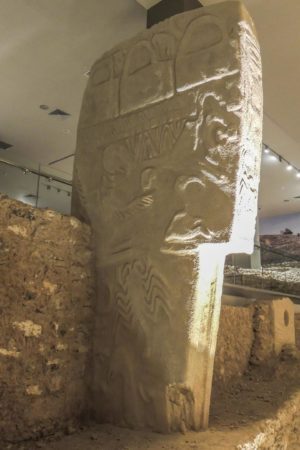
Some of the world’s oldest art has revealed how ancient people had relatively advanced knowledge of astronomy. Animal symbols, such as those used at Gobekli Tepe in modern day Turkey, represent star constellations in the night sky, and are used to mark dates and events such as comet strikes, analysis from the University of Edinburgh suggests. Alistair Coombs
_____________________________
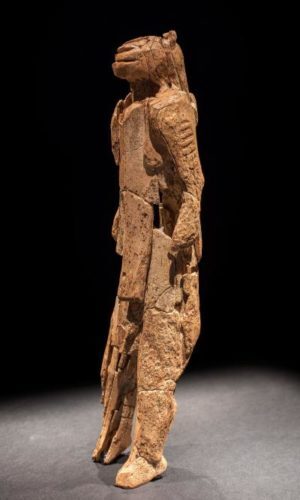
The Lion-Man of Hohlenstein-Stadel Cave. Oleg Kuchar Museum Ulm, Germany
_____________________________
Article Source: University of Edinburgh news release
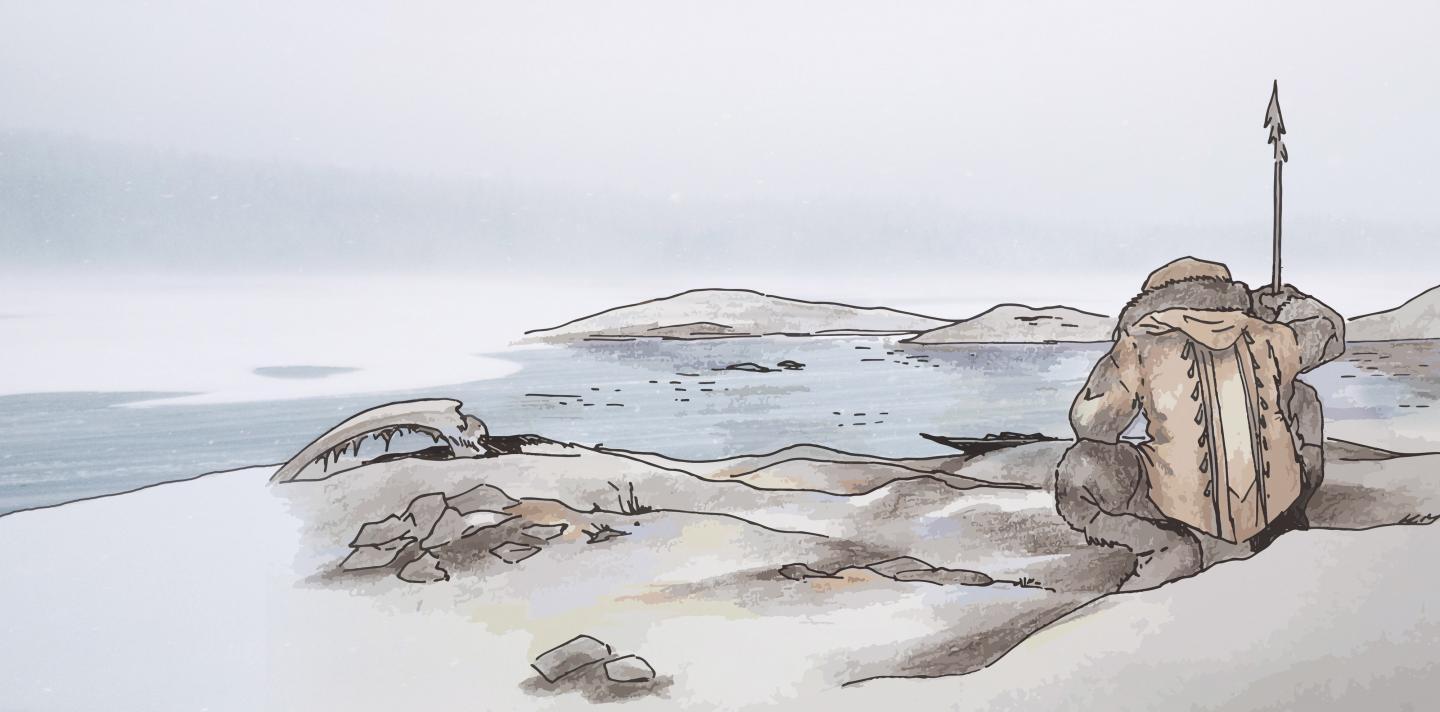
Researchers found the earliest evidence of Siberian ancestry in Fennoscandia in a population inhabiting the Kola Peninsula, in Northwestern Russia, dating to around 4,000 years ago. This genetic ancestry then later spread to populations living in Finland. The study also found that people genetically similar to present-day Saami people inhabited areas in much more southern parts of Finland than the Saami today.
For the present study, genome-wide genetic data from 11 individuals were retrieved. Eight individuals came from the Kola Peninsula, six from a burial dated to 3,500 years ago, and two from an 18th to 19th century Saami cemetery. “We were surprised to find that the oldest samples studied here had the highest proportion of Siberian ancestry,” says Stephan Schiffels, co-senior author of the study, of the Max Planck Institute for the Science of Human History.
The other three individuals analyzed for the study came from a water burial in Levänluhta, Finland. Levänluhta is one of the oldest known burials in Finland in which human bones have been preserved. The bodies were buried in what used to be a small lake or a pond, and this seems to have contributed to exceptionally good preservation of the remains.
Siberian ancestry persists today
The study compared the ancient individuals not only to each other, but also to modern populations, including Saami, Finnish and other Uralic language speakers. Among modern European populations, the Saami have the largest proportion of this ancient Siberian ancestry. Worldwide, the Nganasan people, from north Siberia, have the largest proportion of ancient Siberian ancestry.
“Our results show that there was a strong genetic connection between ancient Finnish and ancient Siberian populations,” says Thiseas Lamnidis, co-first author of the study, “suggesting that ancient populations from Siberia may have also shared a subsistence strategy, languages and/or cultural behaviours with Bronze Age and Iron Age Finns, despite the large geographical distance.” Ancient Finnish populations possibly lived a mobile, nomadic life, trading and moving over a large range, with far-reaching contacts to other populations.
People found in Levänluhta, Finland, most resemble modern-day Saami
The researchers found that the population in Levänluhta was more closely related to modern-day Saami people than to the non-Saami Finnish population today.
“People closely related to the Saami inhabited much more southern regions of Finland than the Saami do today,” explains Kerttu Majander, co-first author, of the University of Helsinki and the Max Planck Institute for the Science of Human History. Interestingly, a recent linguistic study suggested that the place names around Levänluhta trace back to Saami languages.
“This is the first exploration of ancient DNA from Finland and the results are very interesting,” states Schiffels. “However more ancient DNA studies from the area will be necessary to better understand whether the patterns we’ve seen are representative of Finland as a whole.”
The study was conducted as a collaboration between the SUGRIGE-project (Universities of Helsinki and Turku), and the Max Planck Institute for the Science of Human History. The archaeological materials and expertise were provided by the Peter the Great Museum of Anthropology and Ethnography (Kunstkamera) and the Levänluhta-project with the Finnish Heritage Agency.
______________________________
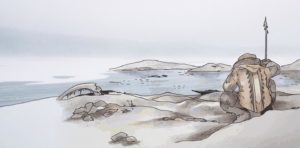
Artistic impression of an ancient fisherman from Bolshoy Oleni Ostrov. Kerttu Majander
______________________________
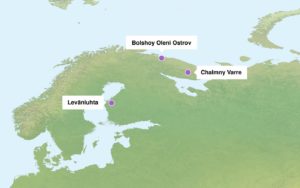
Location of archaeological sites with material used in this study. Michelle O’Reilly; Lamnidis, Majander et al. 2018. Ancient Fennoscandian genomes reveal origin and spread of Siberian ancestry in Europe. Nature Communications, DOI: 10.1038/s41467-018-07483-5.
______________________________
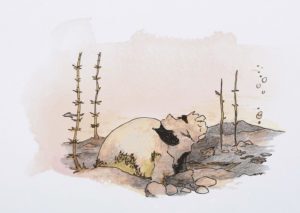
Artistic impression of the Levänluhta water burial site. Kerttu Majander
______________________________
Article Source: Max Planck Institute for the Science of Human History news release.